Business Strategy for Vodafone: Impact of External Environment, Internal Capabilities and Strategic Planning
VerifiedAdded on 2023/06/13
|19
|5235
|141
AI Summary
This report analyzes the impact of external environment on Vodafone's business strategy, evaluates the internal environment and capabilities of the company, and provides a strategic planning framework. It includes PESTLE analysis, stakeholder analysis, SWOT analysis, Ansoff's matrix, and VRIO analysis.
Contribute Materials
Your contribution can guide someone’s learning journey. Share your
documents today.
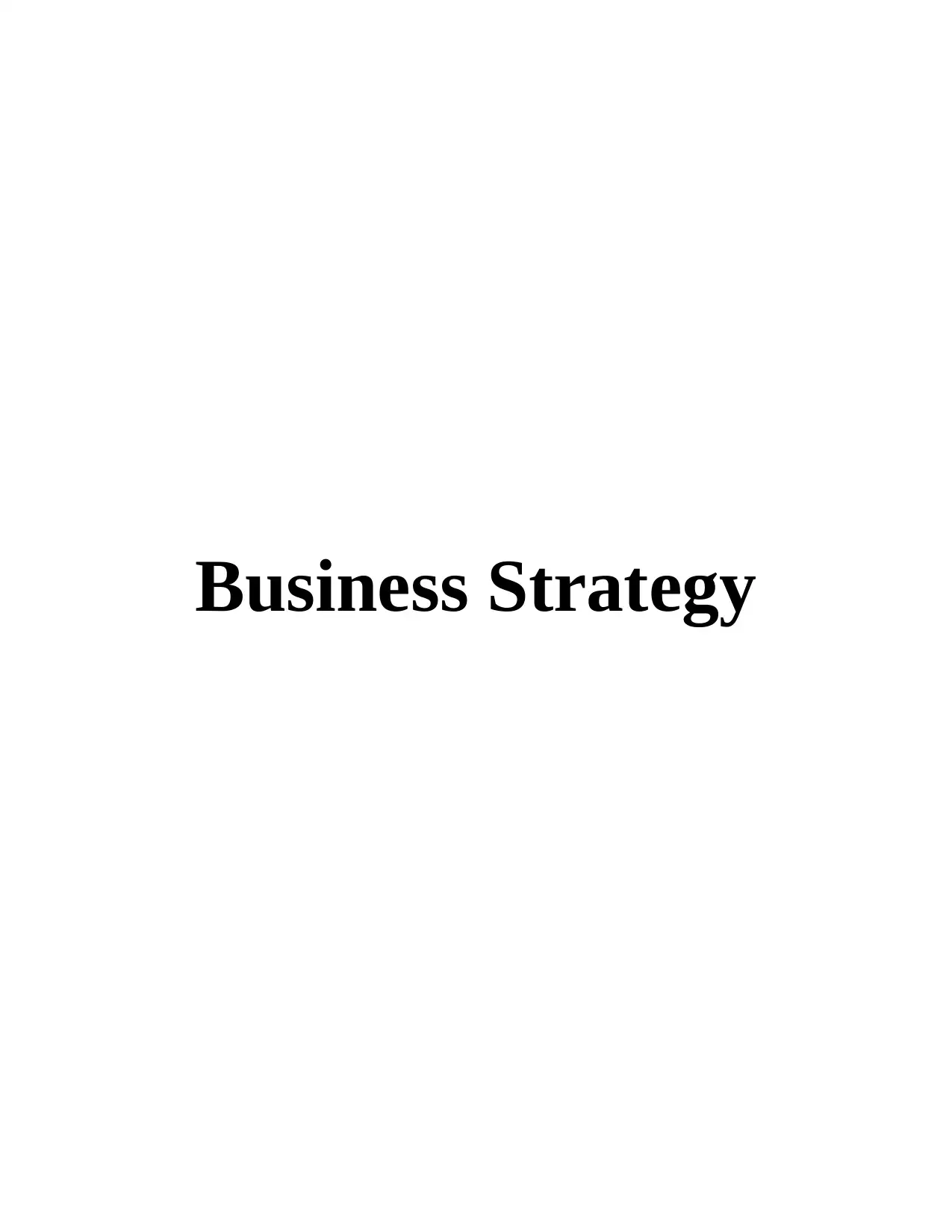
Business Strategy
Secure Best Marks with AI Grader
Need help grading? Try our AI Grader for instant feedback on your assignments.
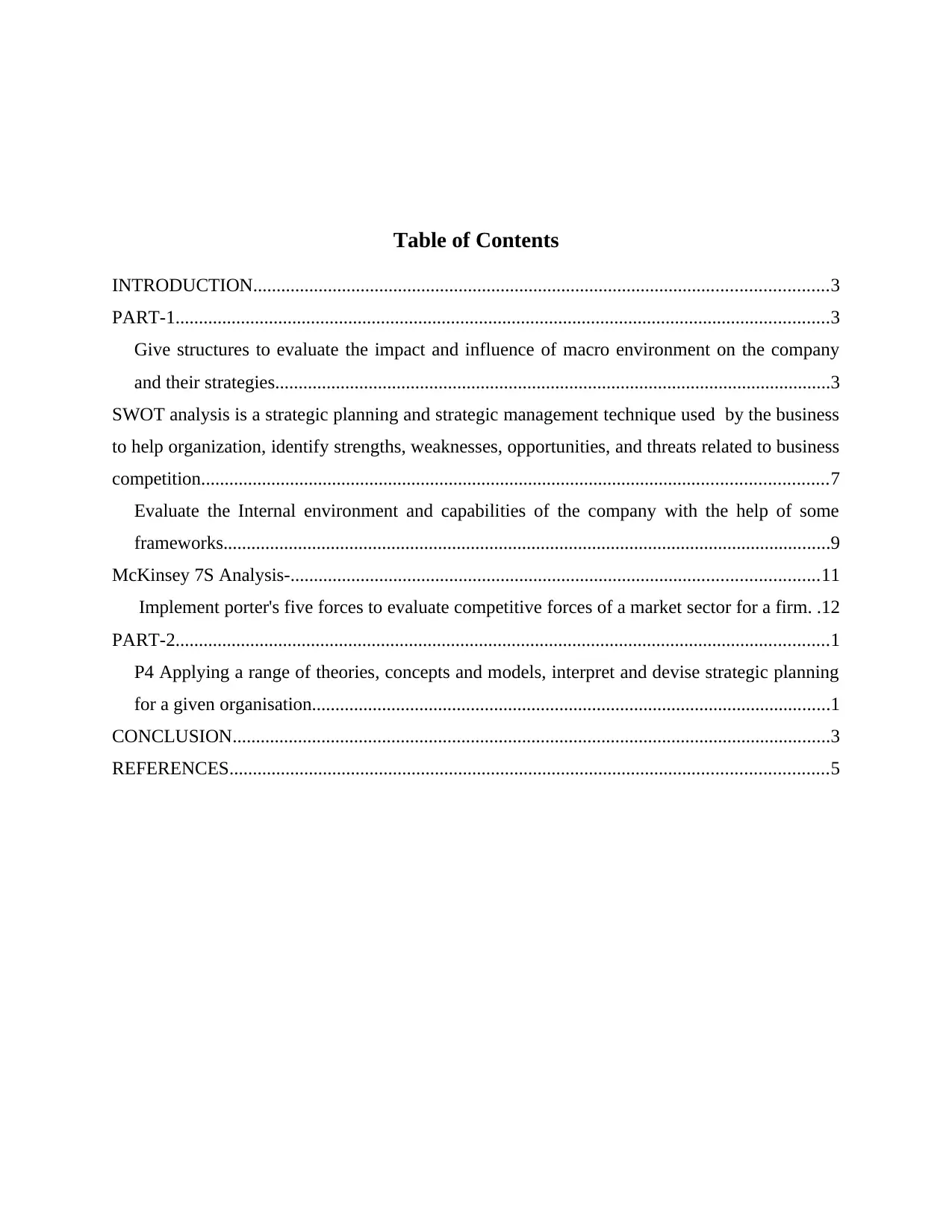
Table of Contents
INTRODUCTION...........................................................................................................................3
PART-1............................................................................................................................................3
Give structures to evaluate the impact and influence of macro environment on the company
and their strategies.......................................................................................................................3
SWOT analysis is a strategic planning and strategic management technique used by the business
to help organization, identify strengths, weaknesses, opportunities, and threats related to business
competition......................................................................................................................................7
Evaluate the Internal environment and capabilities of the company with the help of some
frameworks..................................................................................................................................9
McKinsey 7S Analysis-.................................................................................................................11
Implement porter's five forces to evaluate competitive forces of a market sector for a firm. .12
PART-2............................................................................................................................................1
P4 Applying a range of theories, concepts and models, interpret and devise strategic planning
for a given organisation...............................................................................................................1
CONCLUSION................................................................................................................................3
REFERENCES................................................................................................................................5
INTRODUCTION...........................................................................................................................3
PART-1............................................................................................................................................3
Give structures to evaluate the impact and influence of macro environment on the company
and their strategies.......................................................................................................................3
SWOT analysis is a strategic planning and strategic management technique used by the business
to help organization, identify strengths, weaknesses, opportunities, and threats related to business
competition......................................................................................................................................7
Evaluate the Internal environment and capabilities of the company with the help of some
frameworks..................................................................................................................................9
McKinsey 7S Analysis-.................................................................................................................11
Implement porter's five forces to evaluate competitive forces of a market sector for a firm. .12
PART-2............................................................................................................................................1
P4 Applying a range of theories, concepts and models, interpret and devise strategic planning
for a given organisation...............................................................................................................1
CONCLUSION................................................................................................................................3
REFERENCES................................................................................................................................5
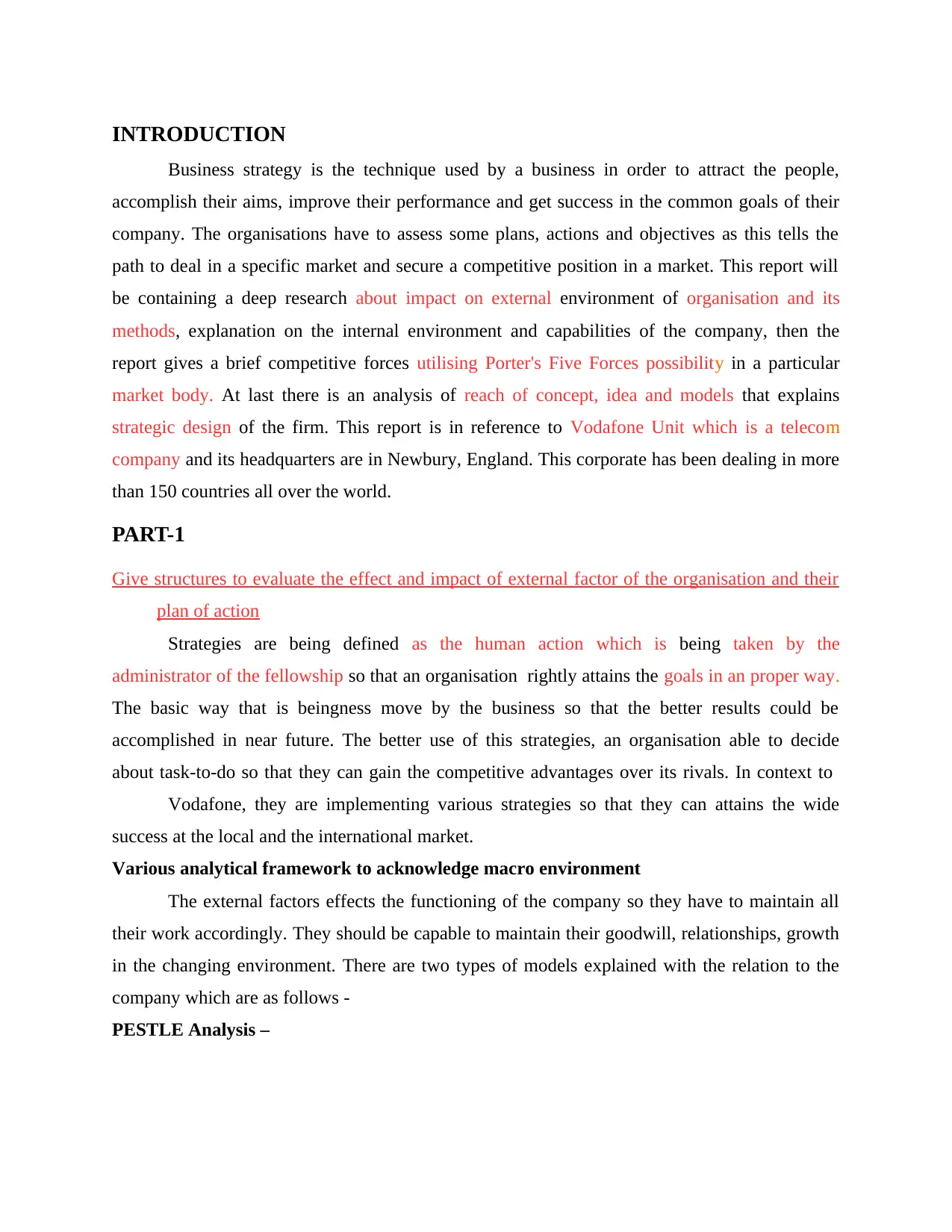
INTRODUCTION
Business strategy is the technique used by a business in order to attract the people,
accomplish their aims, improve their performance and get success in the common goals of their
company. The organisations have to assess some plans, actions and objectives as this tells the
path to deal in a specific market and secure a competitive position in a market. This report will
be containing a deep research about impact on external environment of organisation and its
methods, explanation on the internal environment and capabilities of the company, then the
report gives a brief competitive forces utilising Porter's Five Forces possibility in a particular
market body. At last there is an analysis of reach of concept, idea and models that explains
strategic design of the firm. This report is in reference to Vodafone Unit which is a telecom
company and its headquarters are in Newbury, England. This corporate has been dealing in more
than 150 countries all over the world.
PART-1
Give structures to evaluate the effect and impact of external factor of the organisation and their
plan of action
Strategies are being defined as the human action which is being taken by the
administrator of the fellowship so that an organisation rightly attains the goals in an proper way.
The basic way that is beingness move by the business so that the better results could be
accomplished in near future. The better use of this strategies, an organisation able to decide
about task-to-do so that they can gain the competitive advantages over its rivals. In context to
Vodafone, they are implementing various strategies so that they can attains the wide
success at the local and the international market.
Various analytical framework to acknowledge macro environment
The external factors effects the functioning of the company so they have to maintain all
their work accordingly. They should be capable to maintain their goodwill, relationships, growth
in the changing environment. There are two types of models explained with the relation to the
company which are as follows -
PESTLE Analysis –
Business strategy is the technique used by a business in order to attract the people,
accomplish their aims, improve their performance and get success in the common goals of their
company. The organisations have to assess some plans, actions and objectives as this tells the
path to deal in a specific market and secure a competitive position in a market. This report will
be containing a deep research about impact on external environment of organisation and its
methods, explanation on the internal environment and capabilities of the company, then the
report gives a brief competitive forces utilising Porter's Five Forces possibility in a particular
market body. At last there is an analysis of reach of concept, idea and models that explains
strategic design of the firm. This report is in reference to Vodafone Unit which is a telecom
company and its headquarters are in Newbury, England. This corporate has been dealing in more
than 150 countries all over the world.
PART-1
Give structures to evaluate the effect and impact of external factor of the organisation and their
plan of action
Strategies are being defined as the human action which is being taken by the
administrator of the fellowship so that an organisation rightly attains the goals in an proper way.
The basic way that is beingness move by the business so that the better results could be
accomplished in near future. The better use of this strategies, an organisation able to decide
about task-to-do so that they can gain the competitive advantages over its rivals. In context to
Vodafone, they are implementing various strategies so that they can attains the wide
success at the local and the international market.
Various analytical framework to acknowledge macro environment
The external factors effects the functioning of the company so they have to maintain all
their work accordingly. They should be capable to maintain their goodwill, relationships, growth
in the changing environment. There are two types of models explained with the relation to the
company which are as follows -
PESTLE Analysis –
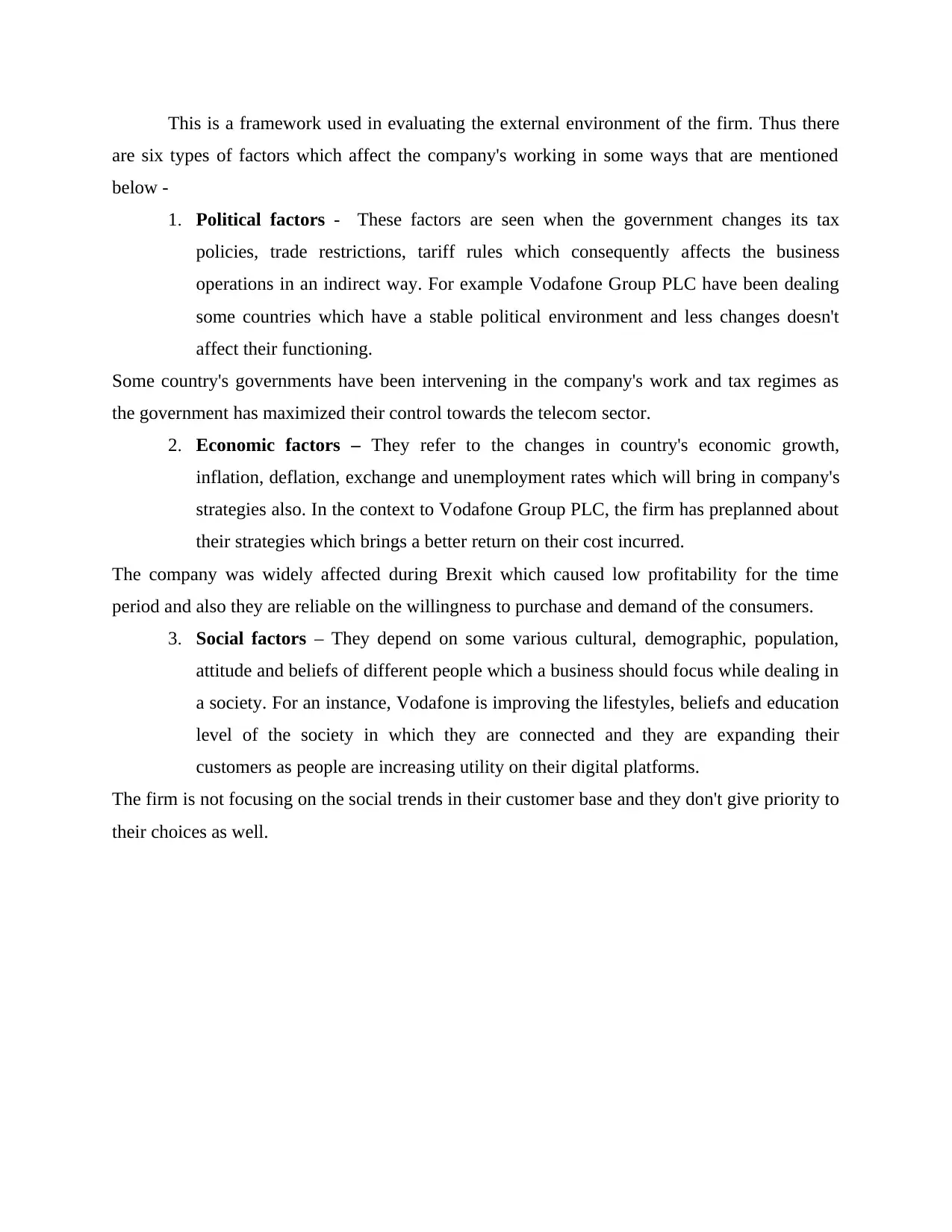
This is a framework used in evaluating the external environment of the firm. Thus there
are six types of factors which affect the company's working in some ways that are mentioned
below -
1. Political factors - These factors are seen when the government changes its tax
policies, trade restrictions, tariff rules which consequently affects the business
operations in an indirect way. For example Vodafone Group PLC have been dealing
some countries which have a stable political environment and less changes doesn't
affect their functioning.
Some country's governments have been intervening in the company's work and tax regimes as
the government has maximized their control towards the telecom sector.
2. Economic factors – They refer to the changes in country's economic growth,
inflation, deflation, exchange and unemployment rates which will bring in company's
strategies also. In the context to Vodafone Group PLC, the firm has preplanned about
their strategies which brings a better return on their cost incurred.
The company was widely affected during Brexit which caused low profitability for the time
period and also they are reliable on the willingness to purchase and demand of the consumers.
3. Social factors – They depend on some various cultural, demographic, population,
attitude and beliefs of different people which a business should focus while dealing in
a society. For an instance, Vodafone is improving the lifestyles, beliefs and education
level of the society in which they are connected and they are expanding their
customers as people are increasing utility on their digital platforms.
The firm is not focusing on the social trends in their customer base and they don't give priority to
their choices as well.
are six types of factors which affect the company's working in some ways that are mentioned
below -
1. Political factors - These factors are seen when the government changes its tax
policies, trade restrictions, tariff rules which consequently affects the business
operations in an indirect way. For example Vodafone Group PLC have been dealing
some countries which have a stable political environment and less changes doesn't
affect their functioning.
Some country's governments have been intervening in the company's work and tax regimes as
the government has maximized their control towards the telecom sector.
2. Economic factors – They refer to the changes in country's economic growth,
inflation, deflation, exchange and unemployment rates which will bring in company's
strategies also. In the context to Vodafone Group PLC, the firm has preplanned about
their strategies which brings a better return on their cost incurred.
The company was widely affected during Brexit which caused low profitability for the time
period and also they are reliable on the willingness to purchase and demand of the consumers.
3. Social factors – They depend on some various cultural, demographic, population,
attitude and beliefs of different people which a business should focus while dealing in
a society. For an instance, Vodafone is improving the lifestyles, beliefs and education
level of the society in which they are connected and they are expanding their
customers as people are increasing utility on their digital platforms.
The firm is not focusing on the social trends in their customer base and they don't give priority to
their choices as well.
Secure Best Marks with AI Grader
Need help grading? Try our AI Grader for instant feedback on your assignments.
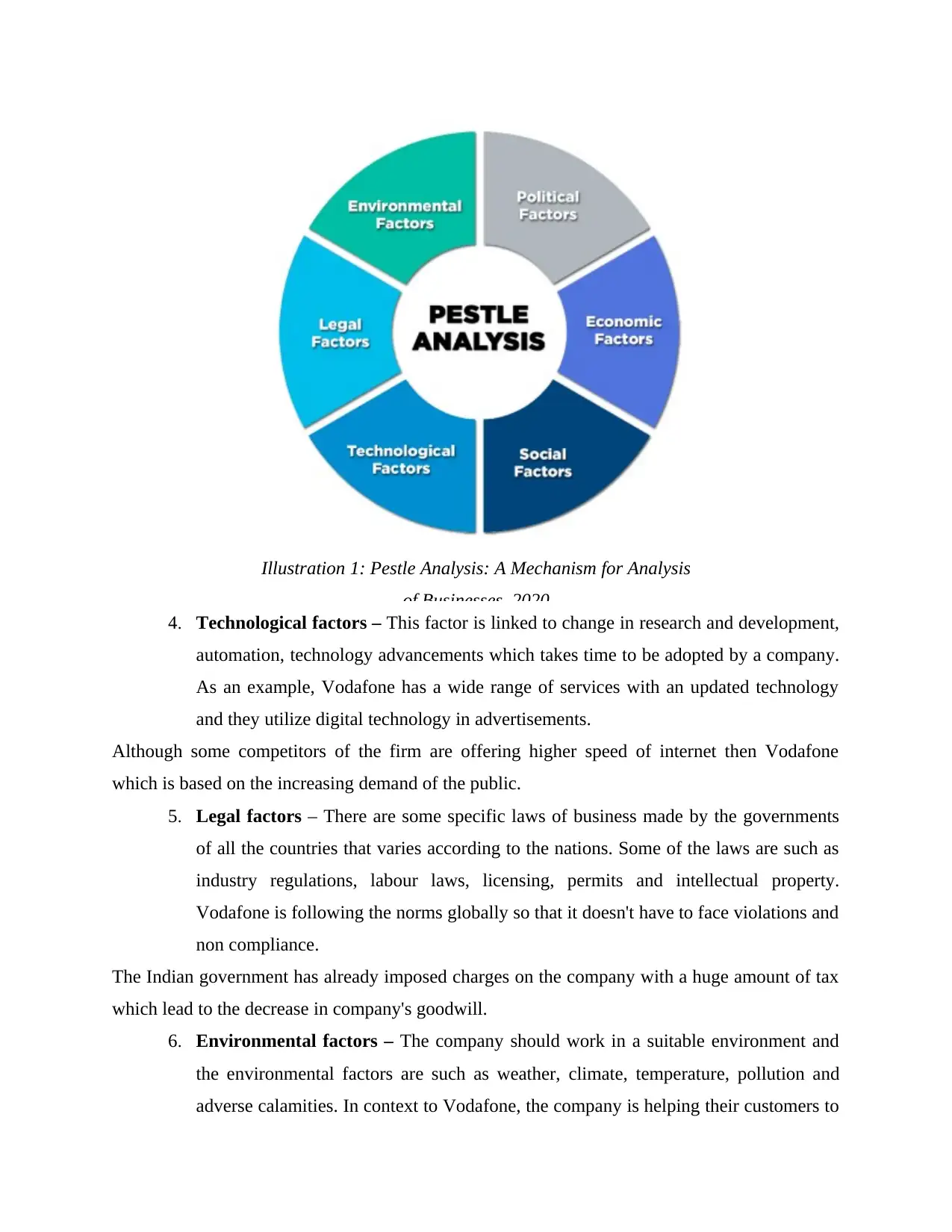
Illustration 1: Pestle Analysis: A Mechanism for Analysis
of Businesses, 2020
4. Technological factors – This factor is linked to change in research and development,
automation, technology advancements which takes time to be adopted by a company.
As an example, Vodafone has a wide range of services with an updated technology
and they utilize digital technology in advertisements.
Although some competitors of the firm are offering higher speed of internet then Vodafone
which is based on the increasing demand of the public.
5. Legal factors – There are some specific laws of business made by the governments
of all the countries that varies according to the nations. Some of the laws are such as
industry regulations, labour laws, licensing, permits and intellectual property.
Vodafone is following the norms globally so that it doesn't have to face violations and
non compliance.
The Indian government has already imposed charges on the company with a huge amount of tax
which lead to the decrease in company's goodwill.
6. Environmental factors – The company should work in a suitable environment and
the environmental factors are such as weather, climate, temperature, pollution and
adverse calamities. In context to Vodafone, the company is helping their customers to
of Businesses, 2020
4. Technological factors – This factor is linked to change in research and development,
automation, technology advancements which takes time to be adopted by a company.
As an example, Vodafone has a wide range of services with an updated technology
and they utilize digital technology in advertisements.
Although some competitors of the firm are offering higher speed of internet then Vodafone
which is based on the increasing demand of the public.
5. Legal factors – There are some specific laws of business made by the governments
of all the countries that varies according to the nations. Some of the laws are such as
industry regulations, labour laws, licensing, permits and intellectual property.
Vodafone is following the norms globally so that it doesn't have to face violations and
non compliance.
The Indian government has already imposed charges on the company with a huge amount of tax
which lead to the decrease in company's goodwill.
6. Environmental factors – The company should work in a suitable environment and
the environmental factors are such as weather, climate, temperature, pollution and
adverse calamities. In context to Vodafone, the company is helping their customers to
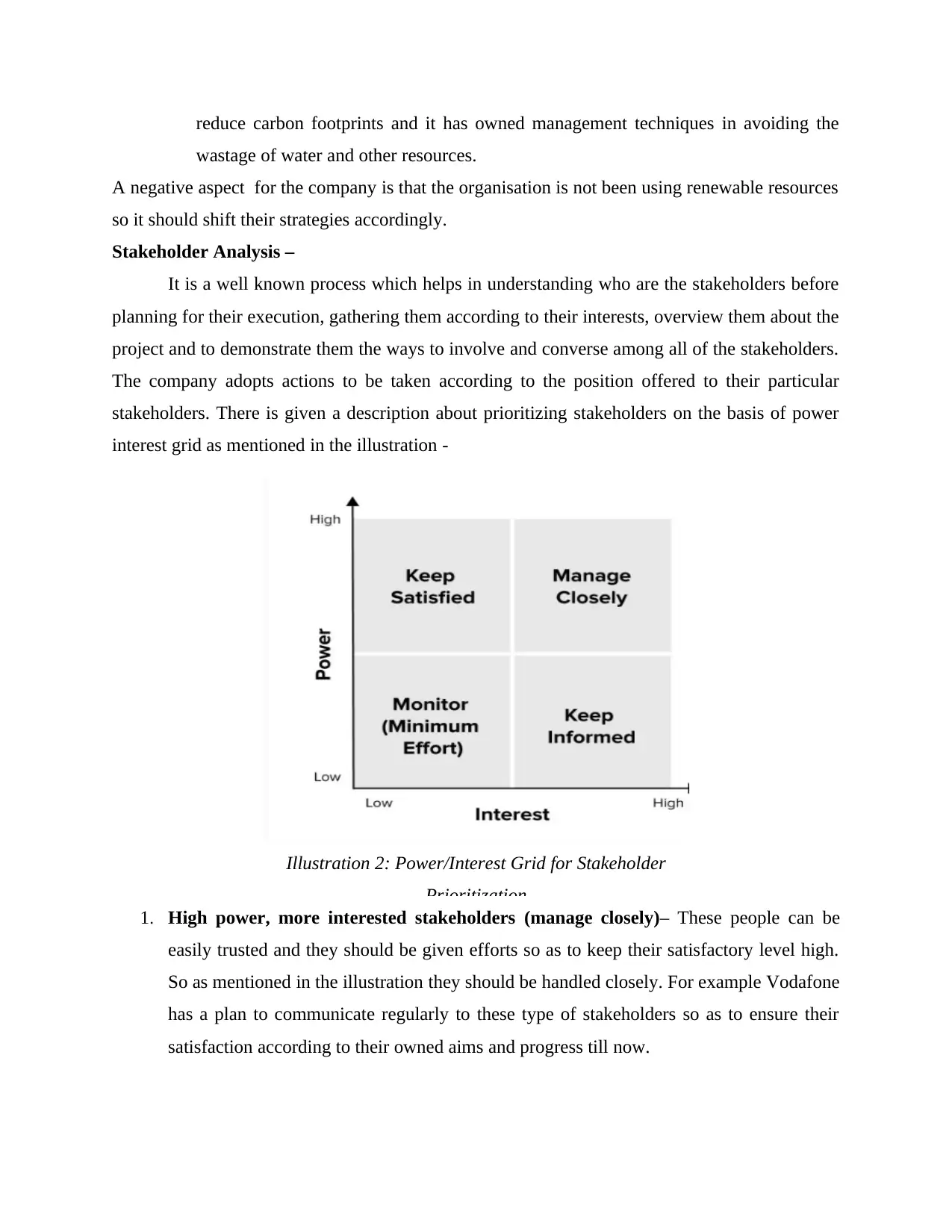
reduce carbon footprints and it has owned management techniques in avoiding the
wastage of water and other resources.
A negative aspect for the company is that the organisation is not been using renewable resources
so it should shift their strategies accordingly.
Stakeholder Analysis –
It is a well known process which helps in understanding who are the stakeholders before
planning for their execution, gathering them according to their interests, overview them about the
project and to demonstrate them the ways to involve and converse among all of the stakeholders.
The company adopts actions to be taken according to the position offered to their particular
stakeholders. There is given a description about prioritizing stakeholders on the basis of power
interest grid as mentioned in the illustration -
1. High power, more interested stakeholders (manage closely)– These people can be
easily trusted and they should be given efforts so as to keep their satisfactory level high.
So as mentioned in the illustration they should be handled closely. For example Vodafone
has a plan to communicate regularly to these type of stakeholders so as to ensure their
satisfaction according to their owned aims and progress till now.
Illustration 2: Power/Interest Grid for Stakeholder
Prioritization
wastage of water and other resources.
A negative aspect for the company is that the organisation is not been using renewable resources
so it should shift their strategies accordingly.
Stakeholder Analysis –
It is a well known process which helps in understanding who are the stakeholders before
planning for their execution, gathering them according to their interests, overview them about the
project and to demonstrate them the ways to involve and converse among all of the stakeholders.
The company adopts actions to be taken according to the position offered to their particular
stakeholders. There is given a description about prioritizing stakeholders on the basis of power
interest grid as mentioned in the illustration -
1. High power, more interested stakeholders (manage closely)– These people can be
easily trusted and they should be given efforts so as to keep their satisfactory level high.
So as mentioned in the illustration they should be handled closely. For example Vodafone
has a plan to communicate regularly to these type of stakeholders so as to ensure their
satisfaction according to their owned aims and progress till now.
Illustration 2: Power/Interest Grid for Stakeholder
Prioritization
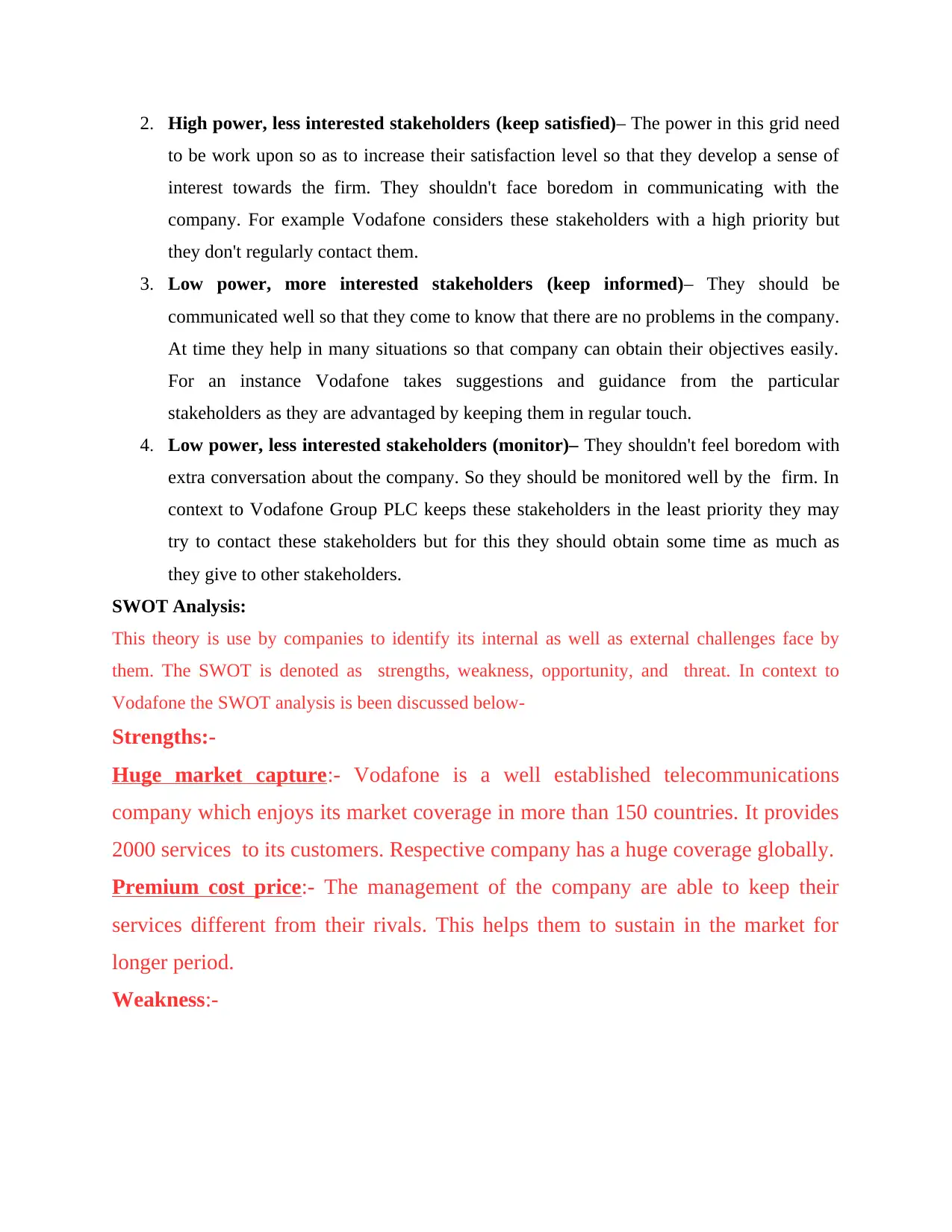
2. High power, less interested stakeholders (keep satisfied)– The power in this grid need
to be work upon so as to increase their satisfaction level so that they develop a sense of
interest towards the firm. They shouldn't face boredom in communicating with the
company. For example Vodafone considers these stakeholders with a high priority but
they don't regularly contact them.
3. Low power, more interested stakeholders (keep informed)– They should be
communicated well so that they come to know that there are no problems in the company.
At time they help in many situations so that company can obtain their objectives easily.
For an instance Vodafone takes suggestions and guidance from the particular
stakeholders as they are advantaged by keeping them in regular touch.
4. Low power, less interested stakeholders (monitor)– They shouldn't feel boredom with
extra conversation about the company. So they should be monitored well by the firm. In
context to Vodafone Group PLC keeps these stakeholders in the least priority they may
try to contact these stakeholders but for this they should obtain some time as much as
they give to other stakeholders.
SWOT Analysis:
This theory is use by companies to identify its internal as well as external challenges face by
them. The SWOT is denoted as strengths, weakness, opportunity, and threat. In context to
Vodafone the SWOT analysis is been discussed below-
Strengths:-
Huge market capture:- Vodafone is a well established telecommunications
company which enjoys its market coverage in more than 150 countries. It provides
2000 services to its customers. Respective company has a huge coverage globally.
Premium cost price:- The management of the company are able to keep their
services different from their rivals. This helps them to sustain in the market for
longer period.
Weakness:-
to be work upon so as to increase their satisfaction level so that they develop a sense of
interest towards the firm. They shouldn't face boredom in communicating with the
company. For example Vodafone considers these stakeholders with a high priority but
they don't regularly contact them.
3. Low power, more interested stakeholders (keep informed)– They should be
communicated well so that they come to know that there are no problems in the company.
At time they help in many situations so that company can obtain their objectives easily.
For an instance Vodafone takes suggestions and guidance from the particular
stakeholders as they are advantaged by keeping them in regular touch.
4. Low power, less interested stakeholders (monitor)– They shouldn't feel boredom with
extra conversation about the company. So they should be monitored well by the firm. In
context to Vodafone Group PLC keeps these stakeholders in the least priority they may
try to contact these stakeholders but for this they should obtain some time as much as
they give to other stakeholders.
SWOT Analysis:
This theory is use by companies to identify its internal as well as external challenges face by
them. The SWOT is denoted as strengths, weakness, opportunity, and threat. In context to
Vodafone the SWOT analysis is been discussed below-
Strengths:-
Huge market capture:- Vodafone is a well established telecommunications
company which enjoys its market coverage in more than 150 countries. It provides
2000 services to its customers. Respective company has a huge coverage globally.
Premium cost price:- The management of the company are able to keep their
services different from their rivals. This helps them to sustain in the market for
longer period.
Weakness:-
Paraphrase This Document
Need a fresh take? Get an instant paraphrase of this document with our AI Paraphraser
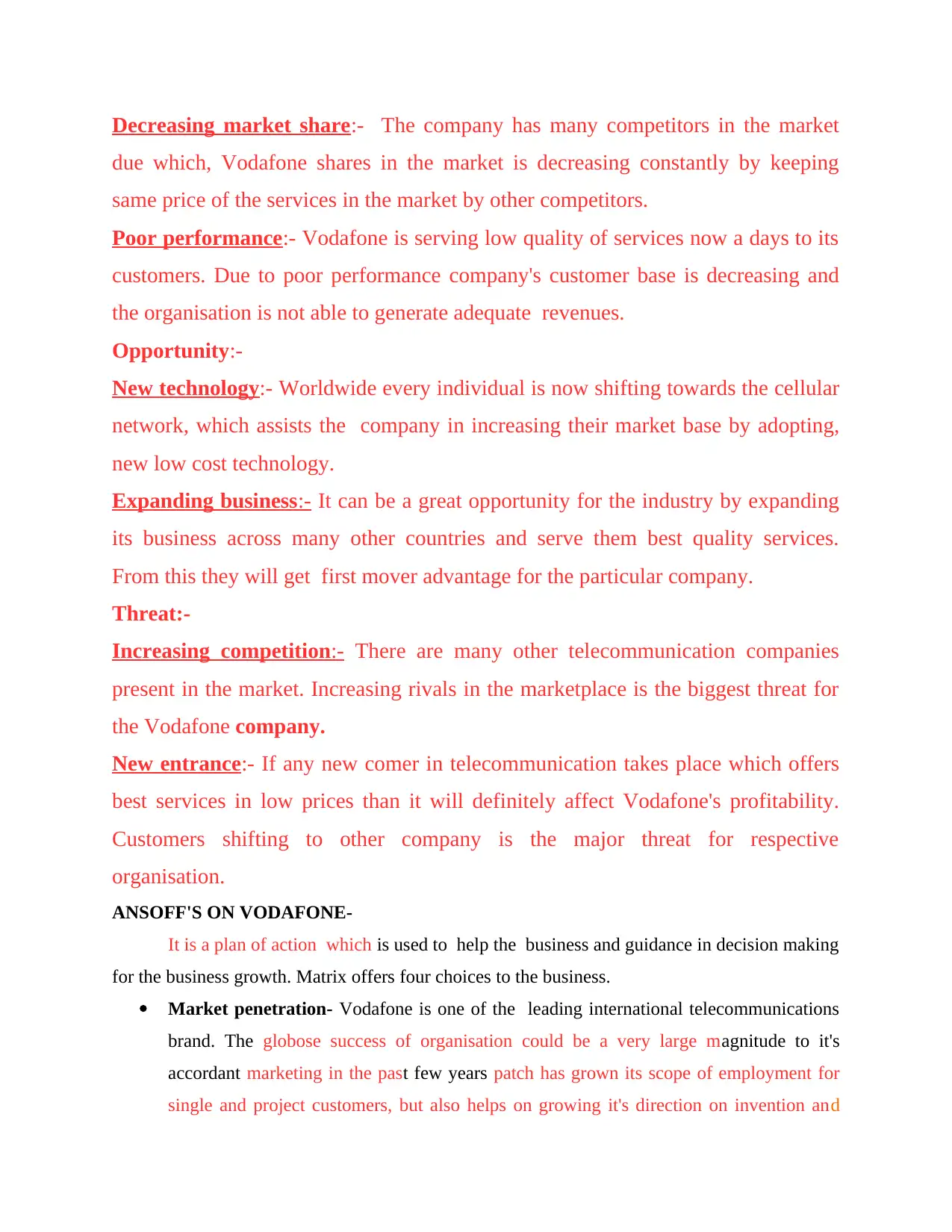
Decreasing market share:- The company has many competitors in the market
due which, Vodafone shares in the market is decreasing constantly by keeping
same price of the services in the market by other competitors.
Poor performance:- Vodafone is serving low quality of services now a days to its
customers. Due to poor performance company's customer base is decreasing and
the organisation is not able to generate adequate revenues.
Opportunity:-
New technology:- Worldwide every individual is now shifting towards the cellular
network, which assists the company in increasing their market base by adopting,
new low cost technology.
Expanding business:- It can be a great opportunity for the industry by expanding
its business across many other countries and serve them best quality services.
From this they will get first mover advantage for the particular company.
Threat:-
Increasing competition:- There are many other telecommunication companies
present in the market. Increasing rivals in the marketplace is the biggest threat for
the Vodafone company.
New entrance:- If any new comer in telecommunication takes place which offers
best services in low prices than it will definitely affect Vodafone's profitability.
Customers shifting to other company is the major threat for respective
organisation.
ANSOFF'S ON VODAFONE-
It is a plan of action which is used to help the business and guidance in decision making
for the business growth. Matrix offers four choices to the business.
Market penetration- Vodafone is one of the leading international telecommunications
brand. The globose success of organisation could be a very large magnitude to it's
accordant marketing in the past few years patch has grown its scope of employment for
single and project customers, but also helps on growing it's direction on invention and
due which, Vodafone shares in the market is decreasing constantly by keeping
same price of the services in the market by other competitors.
Poor performance:- Vodafone is serving low quality of services now a days to its
customers. Due to poor performance company's customer base is decreasing and
the organisation is not able to generate adequate revenues.
Opportunity:-
New technology:- Worldwide every individual is now shifting towards the cellular
network, which assists the company in increasing their market base by adopting,
new low cost technology.
Expanding business:- It can be a great opportunity for the industry by expanding
its business across many other countries and serve them best quality services.
From this they will get first mover advantage for the particular company.
Threat:-
Increasing competition:- There are many other telecommunication companies
present in the market. Increasing rivals in the marketplace is the biggest threat for
the Vodafone company.
New entrance:- If any new comer in telecommunication takes place which offers
best services in low prices than it will definitely affect Vodafone's profitability.
Customers shifting to other company is the major threat for respective
organisation.
ANSOFF'S ON VODAFONE-
It is a plan of action which is used to help the business and guidance in decision making
for the business growth. Matrix offers four choices to the business.
Market penetration- Vodafone is one of the leading international telecommunications
brand. The globose success of organisation could be a very large magnitude to it's
accordant marketing in the past few years patch has grown its scope of employment for
single and project customers, but also helps on growing it's direction on invention and
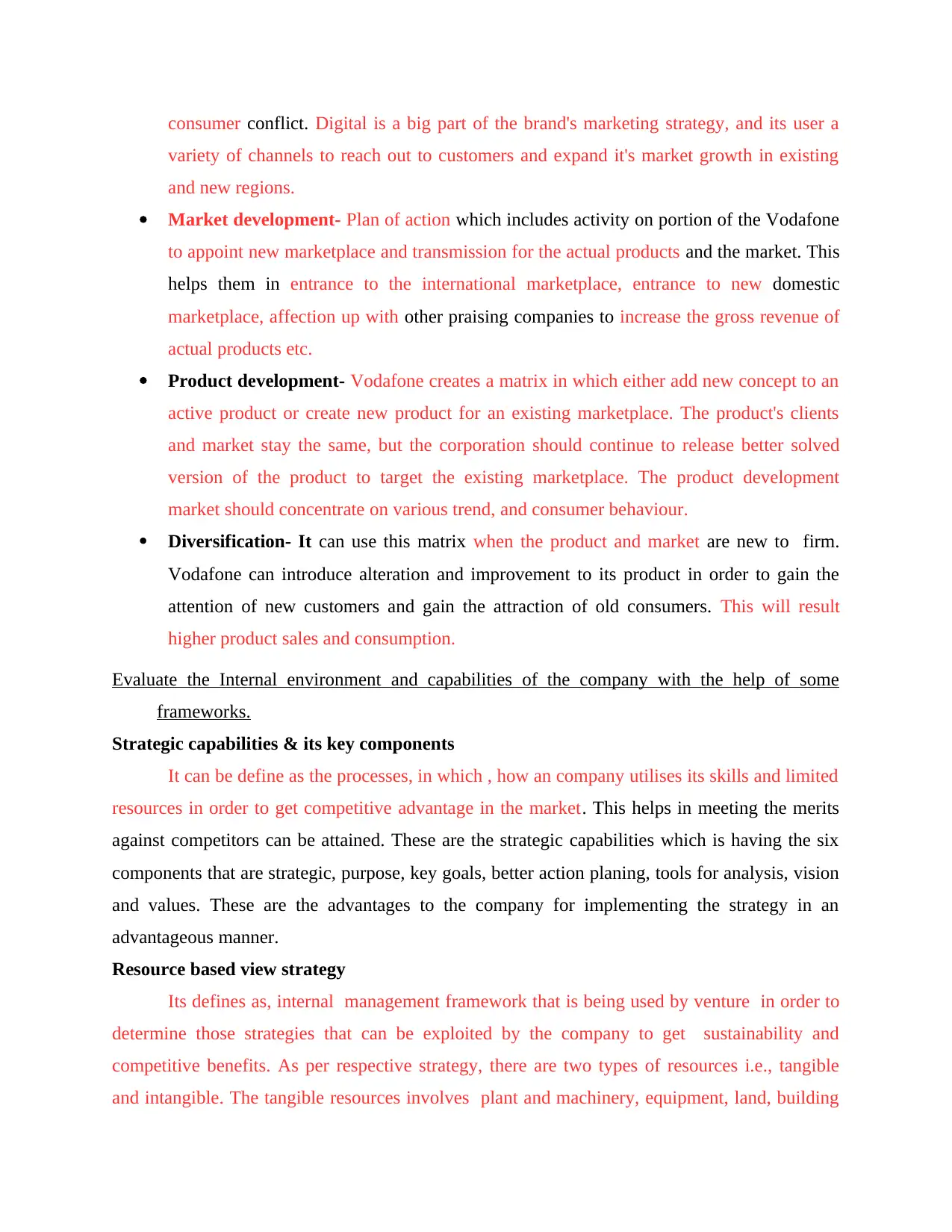
consumer conflict. Digital is a big part of the brand's marketing strategy, and its user a
variety of channels to reach out to customers and expand it's market growth in existing
and new regions.
Market development- Plan of action which includes activity on portion of the Vodafone
to appoint new marketplace and transmission for the actual products and the market. This
helps them in entrance to the international marketplace, entrance to new domestic
marketplace, affection up with other praising companies to increase the gross revenue of
actual products etc.
Product development- Vodafone creates a matrix in which either add new concept to an
active product or create new product for an existing marketplace. The product's clients
and market stay the same, but the corporation should continue to release better solved
version of the product to target the existing marketplace. The product development
market should concentrate on various trend, and consumer behaviour.
Diversification- It can use this matrix when the product and market are new to firm.
Vodafone can introduce alteration and improvement to its product in order to gain the
attention of new customers and gain the attraction of old consumers. This will result
higher product sales and consumption.
Evaluate the Internal environment and capabilities of the company with the help of some
frameworks.
Strategic capabilities & its key components
It can be define as the processes, in which , how an company utilises its skills and limited
resources in order to get competitive advantage in the market. This helps in meeting the merits
against competitors can be attained. These are the strategic capabilities which is having the six
components that are strategic, purpose, key goals, better action planing, tools for analysis, vision
and values. These are the advantages to the company for implementing the strategy in an
advantageous manner.
Resource based view strategy
Its defines as, internal management framework that is being used by venture in order to
determine those strategies that can be exploited by the company to get sustainability and
competitive benefits. As per respective strategy, there are two types of resources i.e., tangible
and intangible. The tangible resources involves plant and machinery, equipment, land, building
variety of channels to reach out to customers and expand it's market growth in existing
and new regions.
Market development- Plan of action which includes activity on portion of the Vodafone
to appoint new marketplace and transmission for the actual products and the market. This
helps them in entrance to the international marketplace, entrance to new domestic
marketplace, affection up with other praising companies to increase the gross revenue of
actual products etc.
Product development- Vodafone creates a matrix in which either add new concept to an
active product or create new product for an existing marketplace. The product's clients
and market stay the same, but the corporation should continue to release better solved
version of the product to target the existing marketplace. The product development
market should concentrate on various trend, and consumer behaviour.
Diversification- It can use this matrix when the product and market are new to firm.
Vodafone can introduce alteration and improvement to its product in order to gain the
attention of new customers and gain the attraction of old consumers. This will result
higher product sales and consumption.
Evaluate the Internal environment and capabilities of the company with the help of some
frameworks.
Strategic capabilities & its key components
It can be define as the processes, in which , how an company utilises its skills and limited
resources in order to get competitive advantage in the market. This helps in meeting the merits
against competitors can be attained. These are the strategic capabilities which is having the six
components that are strategic, purpose, key goals, better action planing, tools for analysis, vision
and values. These are the advantages to the company for implementing the strategy in an
advantageous manner.
Resource based view strategy
Its defines as, internal management framework that is being used by venture in order to
determine those strategies that can be exploited by the company to get sustainability and
competitive benefits. As per respective strategy, there are two types of resources i.e., tangible
and intangible. The tangible resources involves plant and machinery, equipment, land, building

etc. on the other hand intangible resources are those whose have no physical appearance but it
can be managed by Vodafone which are trademarks, intellectual property rights, brand goodwill
etc.
can be managed by Vodafone which are trademarks, intellectual property rights, brand goodwill
etc.
Secure Best Marks with AI Grader
Need help grading? Try our AI Grader for instant feedback on your assignments.
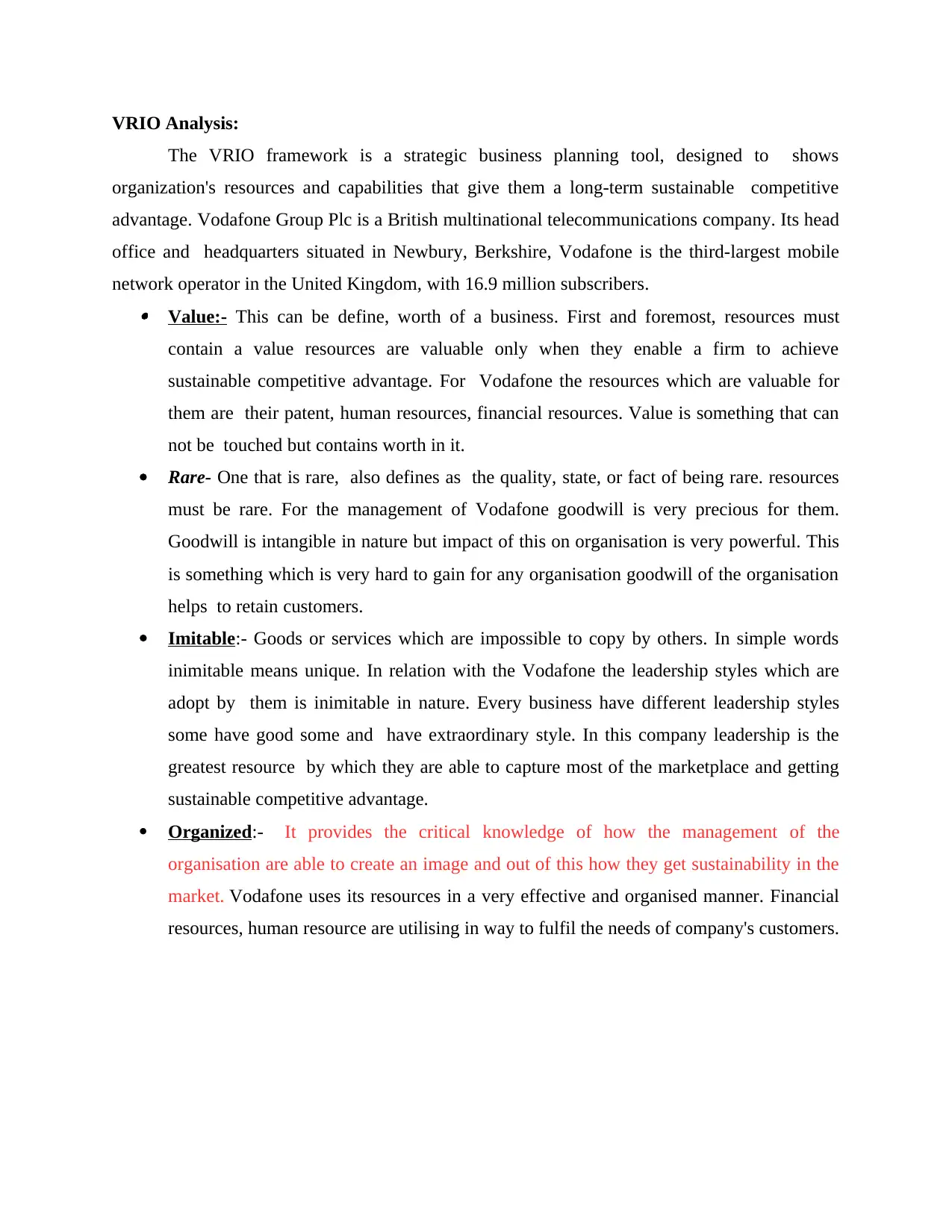
VRIO Analysis:
The VRIO framework is a strategic business planning tool, designed to shows
organization's resources and capabilities that give them a long-term sustainable competitive
advantage. Vodafone Group Plc is a British multinational telecommunications company. Its head
office and headquarters situated in Newbury, Berkshire, Vodafone is the third-largest mobile
network operator in the United Kingdom, with 16.9 million subscribers. Value:- This can be define, worth of a business. First and foremost, resources must
contain a value resources are valuable only when they enable a firm to achieve
sustainable competitive advantage. For Vodafone the resources which are valuable for
them are their patent, human resources, financial resources. Value is something that can
not be touched but contains worth in it.
Rare- One that is rare, also defines as the quality, state, or fact of being rare. resources
must be rare. For the management of Vodafone goodwill is very precious for them.
Goodwill is intangible in nature but impact of this on organisation is very powerful. This
is something which is very hard to gain for any organisation goodwill of the organisation
helps to retain customers.
Imitable:- Goods or services which are impossible to copy by others. In simple words
inimitable means unique. In relation with the Vodafone the leadership styles which are
adopt by them is inimitable in nature. Every business have different leadership styles
some have good some and have extraordinary style. In this company leadership is the
greatest resource by which they are able to capture most of the marketplace and getting
sustainable competitive advantage.
Organized:- It provides the critical knowledge of how the management of the
organisation are able to create an image and out of this how they get sustainability in the
market. Vodafone uses its resources in a very effective and organised manner. Financial
resources, human resource are utilising in way to fulfil the needs of company's customers.
The VRIO framework is a strategic business planning tool, designed to shows
organization's resources and capabilities that give them a long-term sustainable competitive
advantage. Vodafone Group Plc is a British multinational telecommunications company. Its head
office and headquarters situated in Newbury, Berkshire, Vodafone is the third-largest mobile
network operator in the United Kingdom, with 16.9 million subscribers. Value:- This can be define, worth of a business. First and foremost, resources must
contain a value resources are valuable only when they enable a firm to achieve
sustainable competitive advantage. For Vodafone the resources which are valuable for
them are their patent, human resources, financial resources. Value is something that can
not be touched but contains worth in it.
Rare- One that is rare, also defines as the quality, state, or fact of being rare. resources
must be rare. For the management of Vodafone goodwill is very precious for them.
Goodwill is intangible in nature but impact of this on organisation is very powerful. This
is something which is very hard to gain for any organisation goodwill of the organisation
helps to retain customers.
Imitable:- Goods or services which are impossible to copy by others. In simple words
inimitable means unique. In relation with the Vodafone the leadership styles which are
adopt by them is inimitable in nature. Every business have different leadership styles
some have good some and have extraordinary style. In this company leadership is the
greatest resource by which they are able to capture most of the marketplace and getting
sustainable competitive advantage.
Organized:- It provides the critical knowledge of how the management of the
organisation are able to create an image and out of this how they get sustainability in the
market. Vodafone uses its resources in a very effective and organised manner. Financial
resources, human resource are utilising in way to fulfil the needs of company's customers.
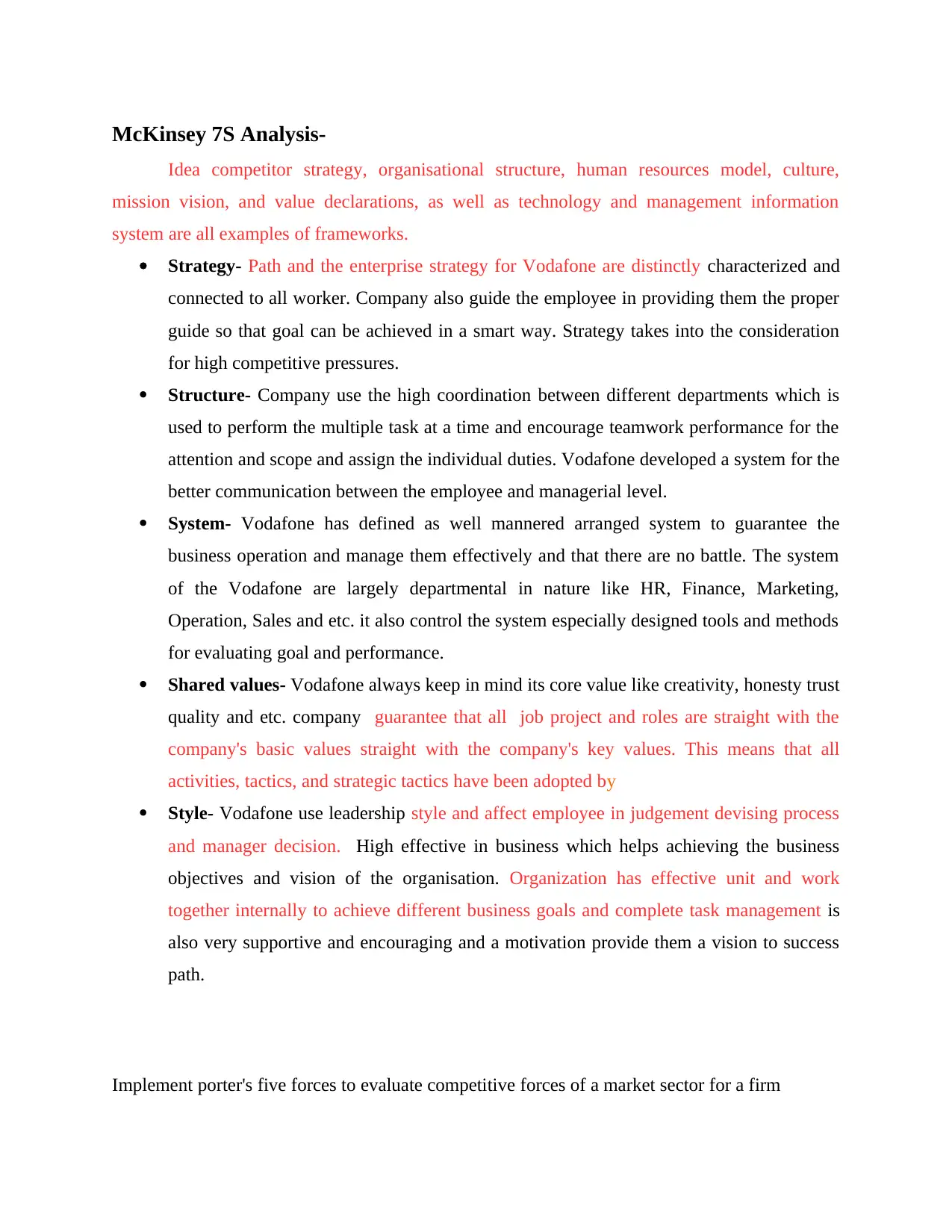
McKinsey 7S Analysis-
Idea competitor strategy, organisational structure, human resources model, culture,
mission vision, and value declarations, as well as technology and management information
system are all examples of frameworks.
Strategy- Path and the enterprise strategy for Vodafone are distinctly characterized and
connected to all worker. Company also guide the employee in providing them the proper
guide so that goal can be achieved in a smart way. Strategy takes into the consideration
for high competitive pressures.
Structure- Company use the high coordination between different departments which is
used to perform the multiple task at a time and encourage teamwork performance for the
attention and scope and assign the individual duties. Vodafone developed a system for the
better communication between the employee and managerial level.
System- Vodafone has defined as well mannered arranged system to guarantee the
business operation and manage them effectively and that there are no battle. The system
of the Vodafone are largely departmental in nature like HR, Finance, Marketing,
Operation, Sales and etc. it also control the system especially designed tools and methods
for evaluating goal and performance.
Shared values- Vodafone always keep in mind its core value like creativity, honesty trust
quality and etc. company guarantee that all job project and roles are straight with the
company's basic values straight with the company's key values. This means that all
activities, tactics, and strategic tactics have been adopted by
Style- Vodafone use leadership style and affect employee in judgement devising process
and manager decision. High effective in business which helps achieving the business
objectives and vision of the organisation. Organization has effective unit and work
together internally to achieve different business goals and complete task management is
also very supportive and encouraging and a motivation provide them a vision to success
path.
Implement porter's five forces to evaluate competitive forces of a market sector for a firm
Idea competitor strategy, organisational structure, human resources model, culture,
mission vision, and value declarations, as well as technology and management information
system are all examples of frameworks.
Strategy- Path and the enterprise strategy for Vodafone are distinctly characterized and
connected to all worker. Company also guide the employee in providing them the proper
guide so that goal can be achieved in a smart way. Strategy takes into the consideration
for high competitive pressures.
Structure- Company use the high coordination between different departments which is
used to perform the multiple task at a time and encourage teamwork performance for the
attention and scope and assign the individual duties. Vodafone developed a system for the
better communication between the employee and managerial level.
System- Vodafone has defined as well mannered arranged system to guarantee the
business operation and manage them effectively and that there are no battle. The system
of the Vodafone are largely departmental in nature like HR, Finance, Marketing,
Operation, Sales and etc. it also control the system especially designed tools and methods
for evaluating goal and performance.
Shared values- Vodafone always keep in mind its core value like creativity, honesty trust
quality and etc. company guarantee that all job project and roles are straight with the
company's basic values straight with the company's key values. This means that all
activities, tactics, and strategic tactics have been adopted by
Style- Vodafone use leadership style and affect employee in judgement devising process
and manager decision. High effective in business which helps achieving the business
objectives and vision of the organisation. Organization has effective unit and work
together internally to achieve different business goals and complete task management is
also very supportive and encouraging and a motivation provide them a vision to success
path.
Implement porter's five forces to evaluate competitive forces of a market sector for a firm
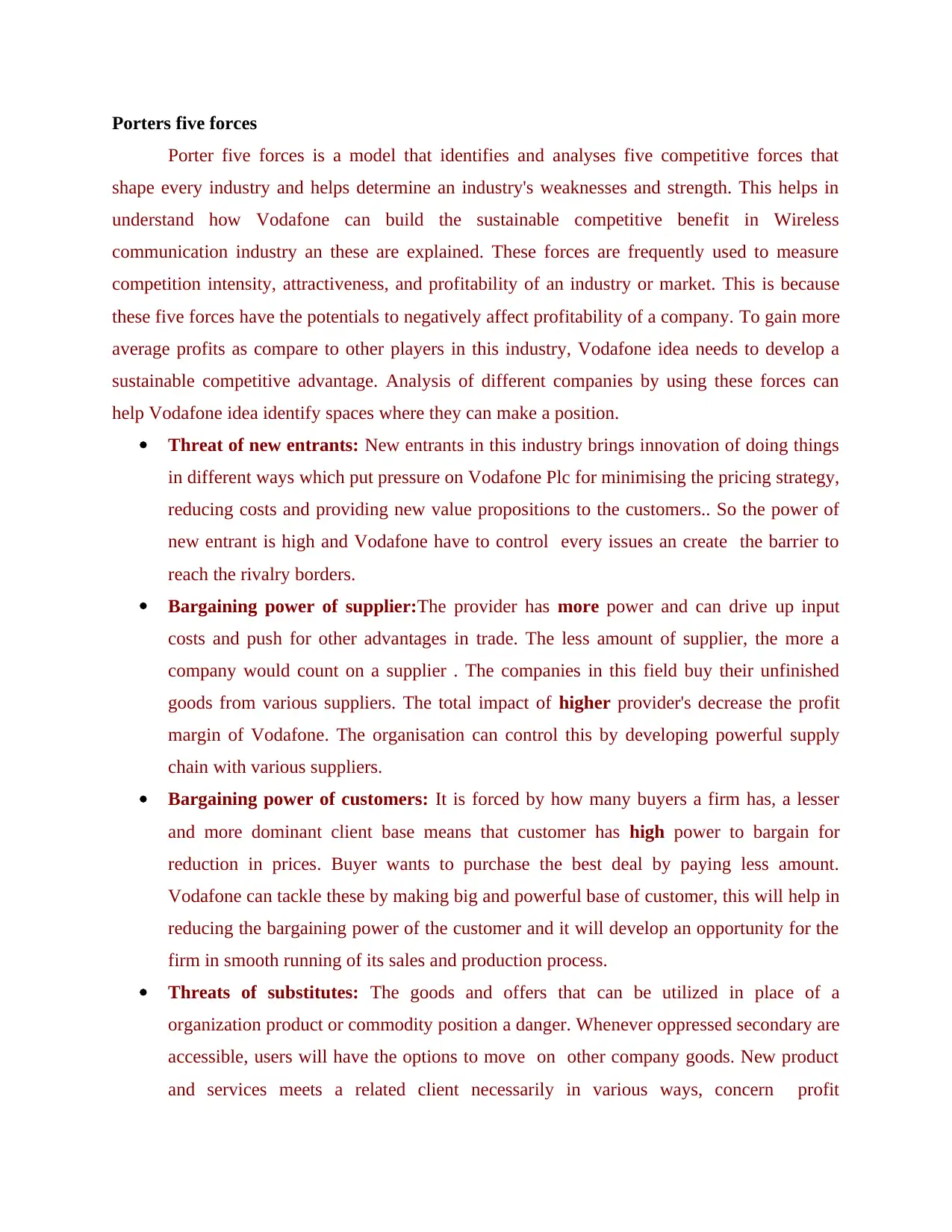
Porters five forces
Porter five forces is a model that identifies and analyses five competitive forces that
shape every industry and helps determine an industry's weaknesses and strength. This helps in
understand how Vodafone can build the sustainable competitive benefit in Wireless
communication industry an these are explained. These forces are frequently used to measure
competition intensity, attractiveness, and profitability of an industry or market. This is because
these five forces have the potentials to negatively affect profitability of a company. To gain more
average profits as compare to other players in this industry, Vodafone idea needs to develop a
sustainable competitive advantage. Analysis of different companies by using these forces can
help Vodafone idea identify spaces where they can make a position.
Threat of new entrants: New entrants in this industry brings innovation of doing things
in different ways which put pressure on Vodafone Plc for minimising the pricing strategy,
reducing costs and providing new value propositions to the customers.. So the power of
new entrant is high and Vodafone have to control every issues an create the barrier to
reach the rivalry borders.
Bargaining power of supplier:The provider has more power and can drive up input
costs and push for other advantages in trade. The less amount of supplier, the more a
company would count on a supplier . The companies in this field buy their unfinished
goods from various suppliers. The total impact of higher provider's decrease the profit
margin of Vodafone. The organisation can control this by developing powerful supply
chain with various suppliers.
Bargaining power of customers: It is forced by how many buyers a firm has, a lesser
and more dominant client base means that customer has high power to bargain for
reduction in prices. Buyer wants to purchase the best deal by paying less amount.
Vodafone can tackle these by making big and powerful base of customer, this will help in
reducing the bargaining power of the customer and it will develop an opportunity for the
firm in smooth running of its sales and production process.
Threats of substitutes: The goods and offers that can be utilized in place of a
organization product or commodity position a danger. Whenever oppressed secondary are
accessible, users will have the options to move on other company goods. New product
and services meets a related client necessarily in various ways, concern profit
Porter five forces is a model that identifies and analyses five competitive forces that
shape every industry and helps determine an industry's weaknesses and strength. This helps in
understand how Vodafone can build the sustainable competitive benefit in Wireless
communication industry an these are explained. These forces are frequently used to measure
competition intensity, attractiveness, and profitability of an industry or market. This is because
these five forces have the potentials to negatively affect profitability of a company. To gain more
average profits as compare to other players in this industry, Vodafone idea needs to develop a
sustainable competitive advantage. Analysis of different companies by using these forces can
help Vodafone idea identify spaces where they can make a position.
Threat of new entrants: New entrants in this industry brings innovation of doing things
in different ways which put pressure on Vodafone Plc for minimising the pricing strategy,
reducing costs and providing new value propositions to the customers.. So the power of
new entrant is high and Vodafone have to control every issues an create the barrier to
reach the rivalry borders.
Bargaining power of supplier:The provider has more power and can drive up input
costs and push for other advantages in trade. The less amount of supplier, the more a
company would count on a supplier . The companies in this field buy their unfinished
goods from various suppliers. The total impact of higher provider's decrease the profit
margin of Vodafone. The organisation can control this by developing powerful supply
chain with various suppliers.
Bargaining power of customers: It is forced by how many buyers a firm has, a lesser
and more dominant client base means that customer has high power to bargain for
reduction in prices. Buyer wants to purchase the best deal by paying less amount.
Vodafone can tackle these by making big and powerful base of customer, this will help in
reducing the bargaining power of the customer and it will develop an opportunity for the
firm in smooth running of its sales and production process.
Threats of substitutes: The goods and offers that can be utilized in place of a
organization product or commodity position a danger. Whenever oppressed secondary are
accessible, users will have the options to move on other company goods. New product
and services meets a related client necessarily in various ways, concern profit
Paraphrase This Document
Need a fresh take? Get an instant paraphrase of this document with our AI Paraphraser
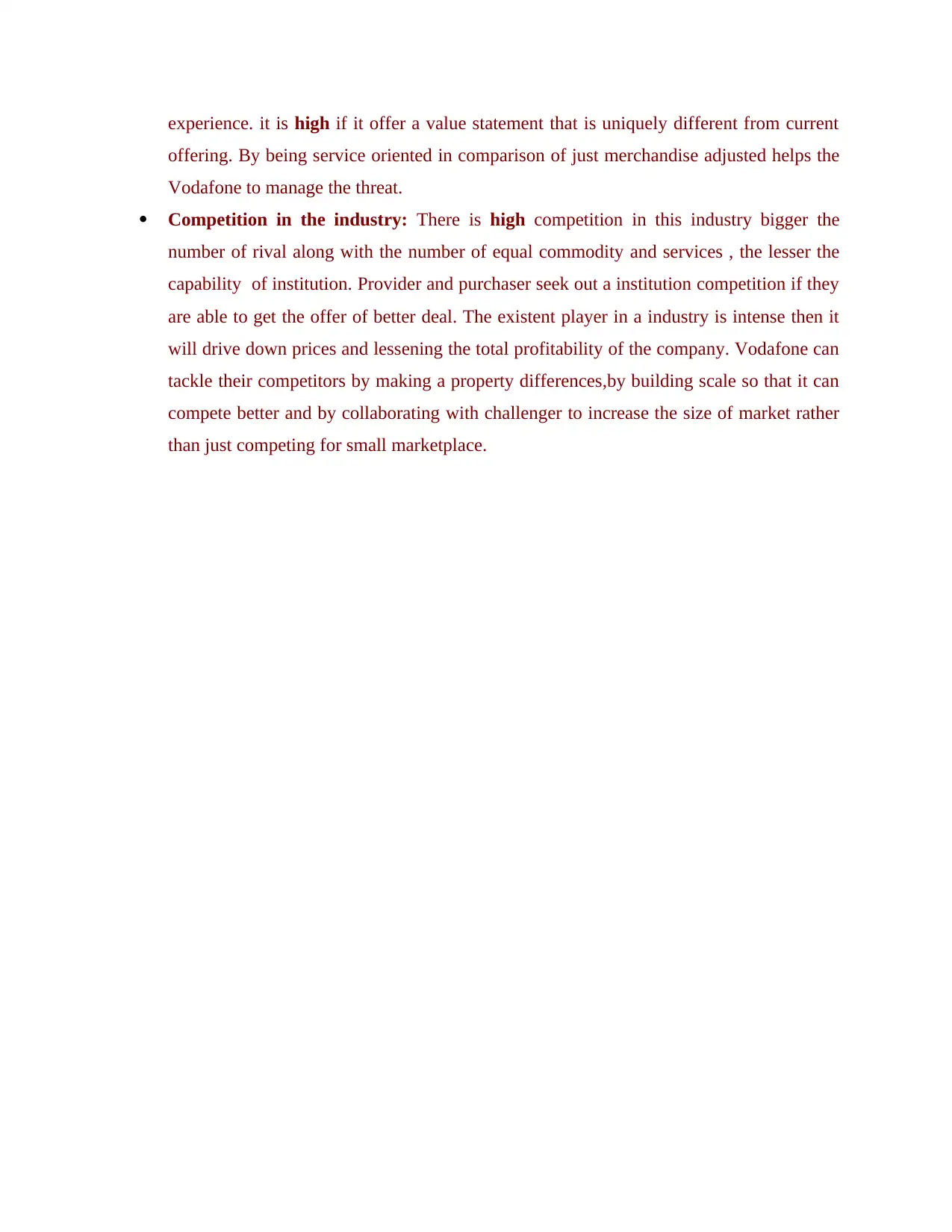
experience. it is high if it offer a value statement that is uniquely different from current
offering. By being service oriented in comparison of just merchandise adjusted helps the
Vodafone to manage the threat.
Competition in the industry: There is high competition in this industry bigger the
number of rival along with the number of equal commodity and services , the lesser the
capability of institution. Provider and purchaser seek out a institution competition if they
are able to get the offer of better deal. The existent player in a industry is intense then it
will drive down prices and lessening the total profitability of the company. Vodafone can
tackle their competitors by making a property differences,by building scale so that it can
compete better and by collaborating with challenger to increase the size of market rather
than just competing for small marketplace.
offering. By being service oriented in comparison of just merchandise adjusted helps the
Vodafone to manage the threat.
Competition in the industry: There is high competition in this industry bigger the
number of rival along with the number of equal commodity and services , the lesser the
capability of institution. Provider and purchaser seek out a institution competition if they
are able to get the offer of better deal. The existent player in a industry is intense then it
will drive down prices and lessening the total profitability of the company. Vodafone can
tackle their competitors by making a property differences,by building scale so that it can
compete better and by collaborating with challenger to increase the size of market rather
than just competing for small marketplace.
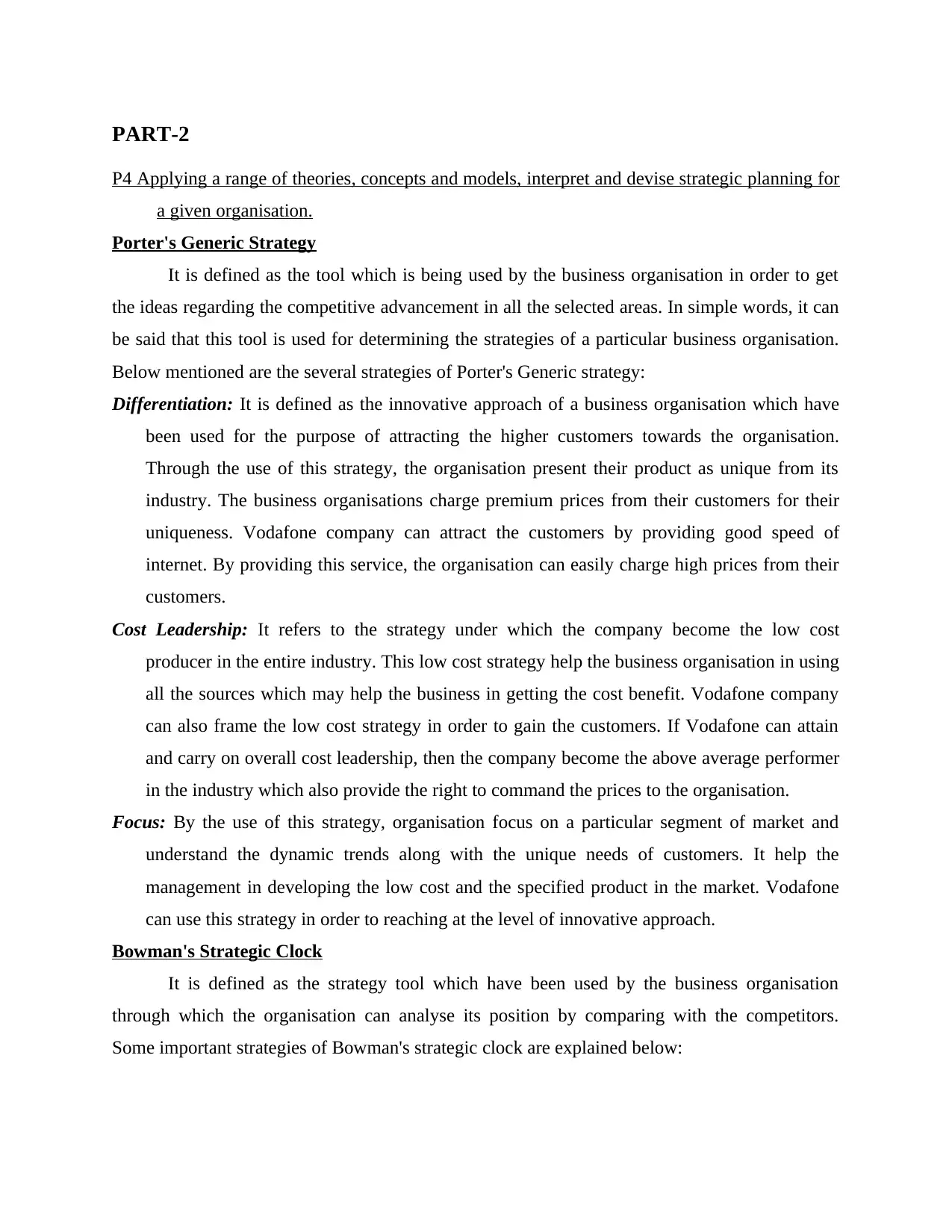
PART-2
P4 Applying a range of theories, concepts and models, interpret and devise strategic planning for
a given organisation.
Porter's Generic Strategy
It is defined as the tool which is being used by the business organisation in order to get
the ideas regarding the competitive advancement in all the selected areas. In simple words, it can
be said that this tool is used for determining the strategies of a particular business organisation.
Below mentioned are the several strategies of Porter's Generic strategy:
Differentiation: It is defined as the innovative approach of a business organisation which have
been used for the purpose of attracting the higher customers towards the organisation.
Through the use of this strategy, the organisation present their product as unique from its
industry. The business organisations charge premium prices from their customers for their
uniqueness. Vodafone company can attract the customers by providing good speed of
internet. By providing this service, the organisation can easily charge high prices from their
customers.
Cost Leadership: It refers to the strategy under which the company become the low cost
producer in the entire industry. This low cost strategy help the business organisation in using
all the sources which may help the business in getting the cost benefit. Vodafone company
can also frame the low cost strategy in order to gain the customers. If Vodafone can attain
and carry on overall cost leadership, then the company become the above average performer
in the industry which also provide the right to command the prices to the organisation.
Focus: By the use of this strategy, organisation focus on a particular segment of market and
understand the dynamic trends along with the unique needs of customers. It help the
management in developing the low cost and the specified product in the market. Vodafone
can use this strategy in order to reaching at the level of innovative approach.
Bowman's Strategic Clock
It is defined as the strategy tool which have been used by the business organisation
through which the organisation can analyse its position by comparing with the competitors.
Some important strategies of Bowman's strategic clock are explained below:
P4 Applying a range of theories, concepts and models, interpret and devise strategic planning for
a given organisation.
Porter's Generic Strategy
It is defined as the tool which is being used by the business organisation in order to get
the ideas regarding the competitive advancement in all the selected areas. In simple words, it can
be said that this tool is used for determining the strategies of a particular business organisation.
Below mentioned are the several strategies of Porter's Generic strategy:
Differentiation: It is defined as the innovative approach of a business organisation which have
been used for the purpose of attracting the higher customers towards the organisation.
Through the use of this strategy, the organisation present their product as unique from its
industry. The business organisations charge premium prices from their customers for their
uniqueness. Vodafone company can attract the customers by providing good speed of
internet. By providing this service, the organisation can easily charge high prices from their
customers.
Cost Leadership: It refers to the strategy under which the company become the low cost
producer in the entire industry. This low cost strategy help the business organisation in using
all the sources which may help the business in getting the cost benefit. Vodafone company
can also frame the low cost strategy in order to gain the customers. If Vodafone can attain
and carry on overall cost leadership, then the company become the above average performer
in the industry which also provide the right to command the prices to the organisation.
Focus: By the use of this strategy, organisation focus on a particular segment of market and
understand the dynamic trends along with the unique needs of customers. It help the
management in developing the low cost and the specified product in the market. Vodafone
can use this strategy in order to reaching at the level of innovative approach.
Bowman's Strategic Clock
It is defined as the strategy tool which have been used by the business organisation
through which the organisation can analyse its position by comparing with the competitors.
Some important strategies of Bowman's strategic clock are explained below:
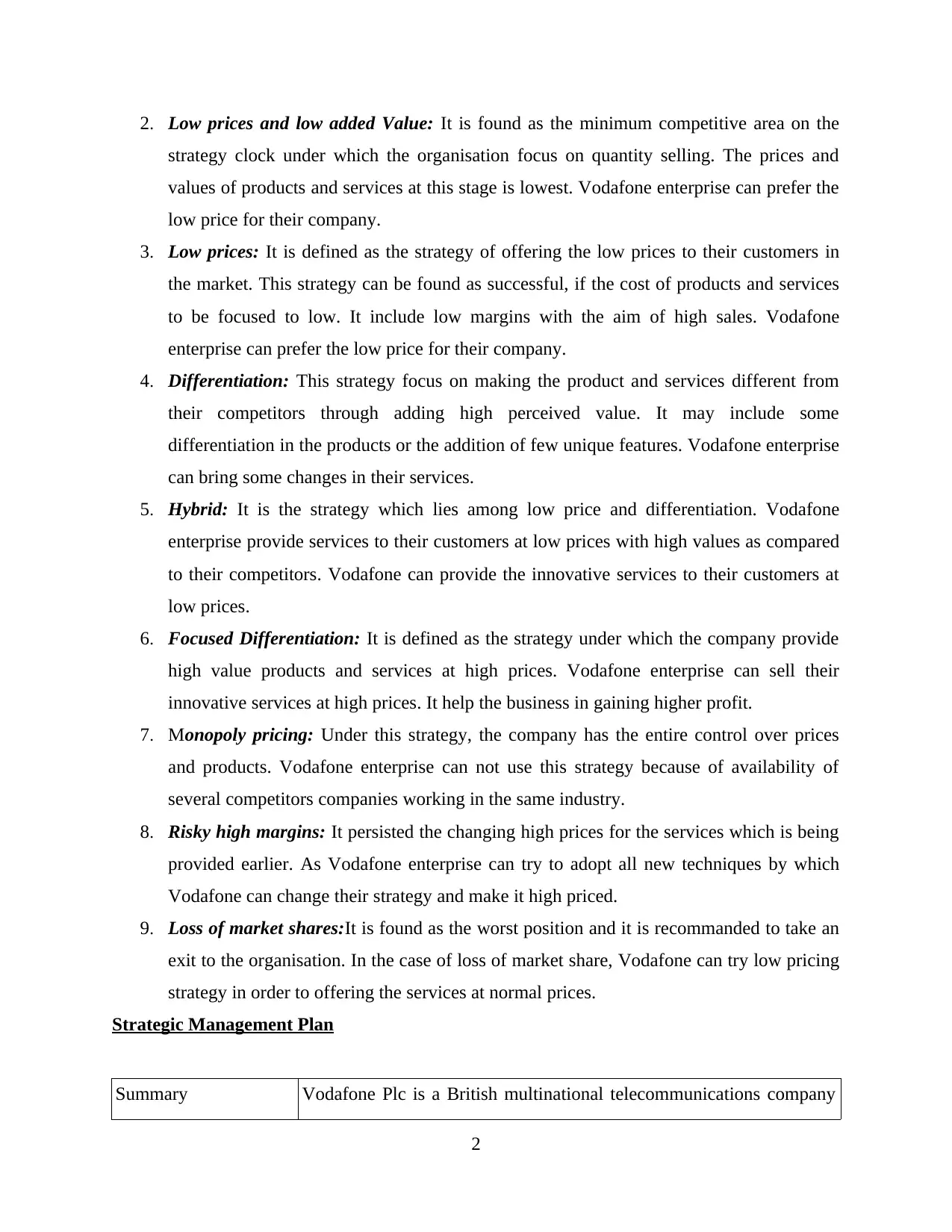
2. Low prices and low added Value: It is found as the minimum competitive area on the
strategy clock under which the organisation focus on quantity selling. The prices and
values of products and services at this stage is lowest. Vodafone enterprise can prefer the
low price for their company.
3. Low prices: It is defined as the strategy of offering the low prices to their customers in
the market. This strategy can be found as successful, if the cost of products and services
to be focused to low. It include low margins with the aim of high sales. Vodafone
enterprise can prefer the low price for their company.
4. Differentiation: This strategy focus on making the product and services different from
their competitors through adding high perceived value. It may include some
differentiation in the products or the addition of few unique features. Vodafone enterprise
can bring some changes in their services.
5. Hybrid: It is the strategy which lies among low price and differentiation. Vodafone
enterprise provide services to their customers at low prices with high values as compared
to their competitors. Vodafone can provide the innovative services to their customers at
low prices.
6. Focused Differentiation: It is defined as the strategy under which the company provide
high value products and services at high prices. Vodafone enterprise can sell their
innovative services at high prices. It help the business in gaining higher profit.
7. Monopoly pricing: Under this strategy, the company has the entire control over prices
and products. Vodafone enterprise can not use this strategy because of availability of
several competitors companies working in the same industry.
8. Risky high margins: It persisted the changing high prices for the services which is being
provided earlier. As Vodafone enterprise can try to adopt all new techniques by which
Vodafone can change their strategy and make it high priced.
9. Loss of market shares:It is found as the worst position and it is recommanded to take an
exit to the organisation. In the case of loss of market share, Vodafone can try low pricing
strategy in order to offering the services at normal prices.
Strategic Management Plan
Summary Vodafone Plc is a British multinational telecommunications company
2
strategy clock under which the organisation focus on quantity selling. The prices and
values of products and services at this stage is lowest. Vodafone enterprise can prefer the
low price for their company.
3. Low prices: It is defined as the strategy of offering the low prices to their customers in
the market. This strategy can be found as successful, if the cost of products and services
to be focused to low. It include low margins with the aim of high sales. Vodafone
enterprise can prefer the low price for their company.
4. Differentiation: This strategy focus on making the product and services different from
their competitors through adding high perceived value. It may include some
differentiation in the products or the addition of few unique features. Vodafone enterprise
can bring some changes in their services.
5. Hybrid: It is the strategy which lies among low price and differentiation. Vodafone
enterprise provide services to their customers at low prices with high values as compared
to their competitors. Vodafone can provide the innovative services to their customers at
low prices.
6. Focused Differentiation: It is defined as the strategy under which the company provide
high value products and services at high prices. Vodafone enterprise can sell their
innovative services at high prices. It help the business in gaining higher profit.
7. Monopoly pricing: Under this strategy, the company has the entire control over prices
and products. Vodafone enterprise can not use this strategy because of availability of
several competitors companies working in the same industry.
8. Risky high margins: It persisted the changing high prices for the services which is being
provided earlier. As Vodafone enterprise can try to adopt all new techniques by which
Vodafone can change their strategy and make it high priced.
9. Loss of market shares:It is found as the worst position and it is recommanded to take an
exit to the organisation. In the case of loss of market share, Vodafone can try low pricing
strategy in order to offering the services at normal prices.
Strategic Management Plan
Summary Vodafone Plc is a British multinational telecommunications company
2
Secure Best Marks with AI Grader
Need help grading? Try our AI Grader for instant feedback on your assignments.
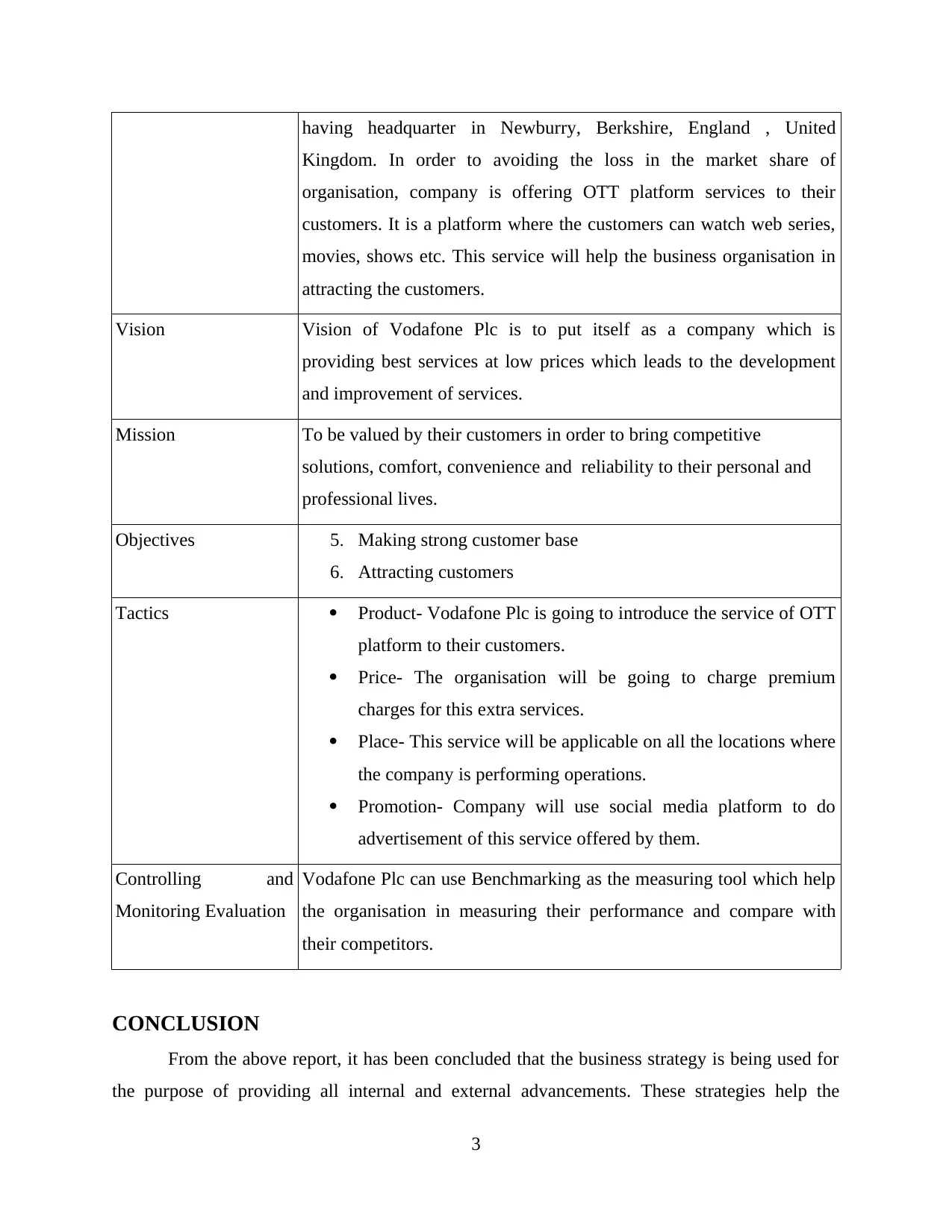
having headquarter in Newburry, Berkshire, England , United
Kingdom. In order to avoiding the loss in the market share of
organisation, company is offering OTT platform services to their
customers. It is a platform where the customers can watch web series,
movies, shows etc. This service will help the business organisation in
attracting the customers.
Vision Vision of Vodafone Plc is to put itself as a company which is
providing best services at low prices which leads to the development
and improvement of services.
Mission To be valued by their customers in order to bring competitive
solutions, comfort, convenience and reliability to their personal and
professional lives.
Objectives 5. Making strong customer base
6. Attracting customers
Tactics Product- Vodafone Plc is going to introduce the service of OTT
platform to their customers.
Price- The organisation will be going to charge premium
charges for this extra services.
Place- This service will be applicable on all the locations where
the company is performing operations.
Promotion- Company will use social media platform to do
advertisement of this service offered by them.
Controlling and
Monitoring Evaluation
Vodafone Plc can use Benchmarking as the measuring tool which help
the organisation in measuring their performance and compare with
their competitors.
CONCLUSION
From the above report, it has been concluded that the business strategy is being used for
the purpose of providing all internal and external advancements. These strategies help the
3
Kingdom. In order to avoiding the loss in the market share of
organisation, company is offering OTT platform services to their
customers. It is a platform where the customers can watch web series,
movies, shows etc. This service will help the business organisation in
attracting the customers.
Vision Vision of Vodafone Plc is to put itself as a company which is
providing best services at low prices which leads to the development
and improvement of services.
Mission To be valued by their customers in order to bring competitive
solutions, comfort, convenience and reliability to their personal and
professional lives.
Objectives 5. Making strong customer base
6. Attracting customers
Tactics Product- Vodafone Plc is going to introduce the service of OTT
platform to their customers.
Price- The organisation will be going to charge premium
charges for this extra services.
Place- This service will be applicable on all the locations where
the company is performing operations.
Promotion- Company will use social media platform to do
advertisement of this service offered by them.
Controlling and
Monitoring Evaluation
Vodafone Plc can use Benchmarking as the measuring tool which help
the organisation in measuring their performance and compare with
their competitors.
CONCLUSION
From the above report, it has been concluded that the business strategy is being used for
the purpose of providing all internal and external advancements. These strategies help the
3
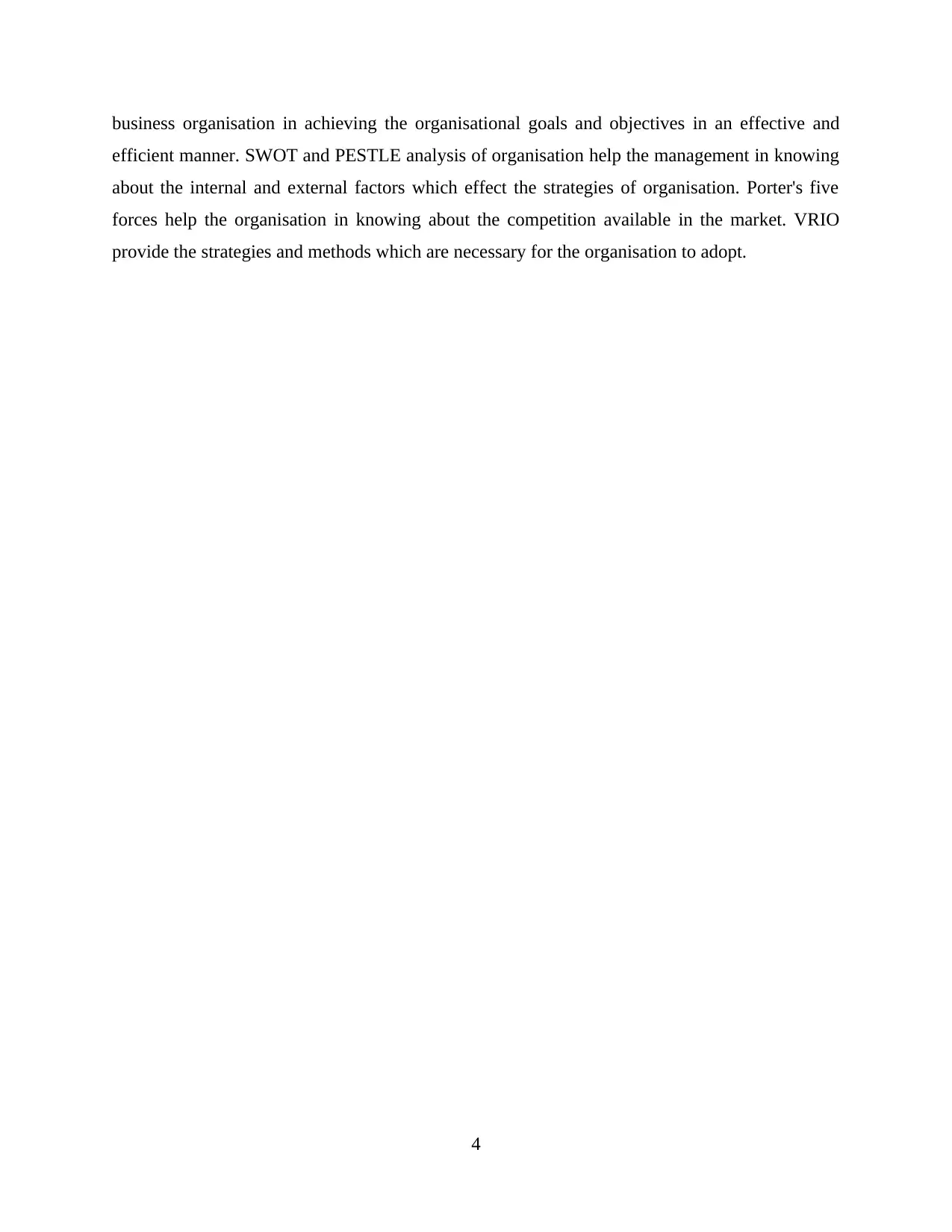
business organisation in achieving the organisational goals and objectives in an effective and
efficient manner. SWOT and PESTLE analysis of organisation help the management in knowing
about the internal and external factors which effect the strategies of organisation. Porter's five
forces help the organisation in knowing about the competition available in the market. VRIO
provide the strategies and methods which are necessary for the organisation to adopt.
4
efficient manner. SWOT and PESTLE analysis of organisation help the management in knowing
about the internal and external factors which effect the strategies of organisation. Porter's five
forces help the organisation in knowing about the competition available in the market. VRIO
provide the strategies and methods which are necessary for the organisation to adopt.
4
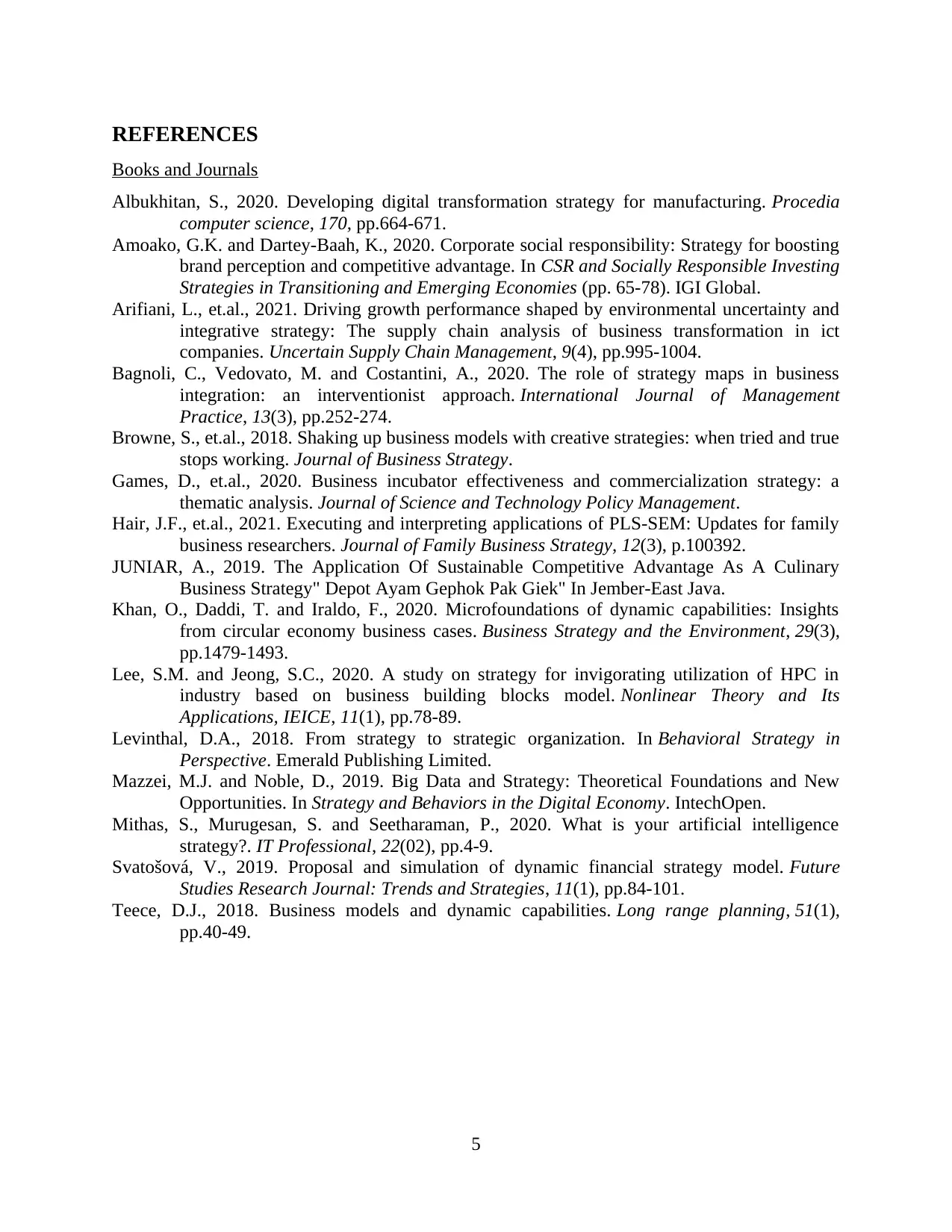
REFERENCES
Books and Journals
Albukhitan, S., 2020. Developing digital transformation strategy for manufacturing. Procedia
computer science, 170, pp.664-671.
Amoako, G.K. and Dartey-Baah, K., 2020. Corporate social responsibility: Strategy for boosting
brand perception and competitive advantage. In CSR and Socially Responsible Investing
Strategies in Transitioning and Emerging Economies (pp. 65-78). IGI Global.
Arifiani, L., et.al., 2021. Driving growth performance shaped by environmental uncertainty and
integrative strategy: The supply chain analysis of business transformation in ict
companies. Uncertain Supply Chain Management, 9(4), pp.995-1004.
Bagnoli, C., Vedovato, M. and Costantini, A., 2020. The role of strategy maps in business
integration: an interventionist approach. International Journal of Management
Practice, 13(3), pp.252-274.
Browne, S., et.al., 2018. Shaking up business models with creative strategies: when tried and true
stops working. Journal of Business Strategy.
Games, D., et.al., 2020. Business incubator effectiveness and commercialization strategy: a
thematic analysis. Journal of Science and Technology Policy Management.
Hair, J.F., et.al., 2021. Executing and interpreting applications of PLS-SEM: Updates for family
business researchers. Journal of Family Business Strategy, 12(3), p.100392.
JUNIAR, A., 2019. The Application Of Sustainable Competitive Advantage As A Culinary
Business Strategy" Depot Ayam Gephok Pak Giek" In Jember-East Java.
Khan, O., Daddi, T. and Iraldo, F., 2020. Microfoundations of dynamic capabilities: Insights
from circular economy business cases. Business Strategy and the Environment, 29(3),
pp.1479-1493.
Lee, S.M. and Jeong, S.C., 2020. A study on strategy for invigorating utilization of HPC in
industry based on business building blocks model. Nonlinear Theory and Its
Applications, IEICE, 11(1), pp.78-89.
Levinthal, D.A., 2018. From strategy to strategic organization. In Behavioral Strategy in
Perspective. Emerald Publishing Limited.
Mazzei, M.J. and Noble, D., 2019. Big Data and Strategy: Theoretical Foundations and New
Opportunities. In Strategy and Behaviors in the Digital Economy. IntechOpen.
Mithas, S., Murugesan, S. and Seetharaman, P., 2020. What is your artificial intelligence
strategy?. IT Professional, 22(02), pp.4-9.
Svatošová, V., 2019. Proposal and simulation of dynamic financial strategy model. Future
Studies Research Journal: Trends and Strategies, 11(1), pp.84-101.
Teece, D.J., 2018. Business models and dynamic capabilities. Long range planning, 51(1),
pp.40-49.
5
Books and Journals
Albukhitan, S., 2020. Developing digital transformation strategy for manufacturing. Procedia
computer science, 170, pp.664-671.
Amoako, G.K. and Dartey-Baah, K., 2020. Corporate social responsibility: Strategy for boosting
brand perception and competitive advantage. In CSR and Socially Responsible Investing
Strategies in Transitioning and Emerging Economies (pp. 65-78). IGI Global.
Arifiani, L., et.al., 2021. Driving growth performance shaped by environmental uncertainty and
integrative strategy: The supply chain analysis of business transformation in ict
companies. Uncertain Supply Chain Management, 9(4), pp.995-1004.
Bagnoli, C., Vedovato, M. and Costantini, A., 2020. The role of strategy maps in business
integration: an interventionist approach. International Journal of Management
Practice, 13(3), pp.252-274.
Browne, S., et.al., 2018. Shaking up business models with creative strategies: when tried and true
stops working. Journal of Business Strategy.
Games, D., et.al., 2020. Business incubator effectiveness and commercialization strategy: a
thematic analysis. Journal of Science and Technology Policy Management.
Hair, J.F., et.al., 2021. Executing and interpreting applications of PLS-SEM: Updates for family
business researchers. Journal of Family Business Strategy, 12(3), p.100392.
JUNIAR, A., 2019. The Application Of Sustainable Competitive Advantage As A Culinary
Business Strategy" Depot Ayam Gephok Pak Giek" In Jember-East Java.
Khan, O., Daddi, T. and Iraldo, F., 2020. Microfoundations of dynamic capabilities: Insights
from circular economy business cases. Business Strategy and the Environment, 29(3),
pp.1479-1493.
Lee, S.M. and Jeong, S.C., 2020. A study on strategy for invigorating utilization of HPC in
industry based on business building blocks model. Nonlinear Theory and Its
Applications, IEICE, 11(1), pp.78-89.
Levinthal, D.A., 2018. From strategy to strategic organization. In Behavioral Strategy in
Perspective. Emerald Publishing Limited.
Mazzei, M.J. and Noble, D., 2019. Big Data and Strategy: Theoretical Foundations and New
Opportunities. In Strategy and Behaviors in the Digital Economy. IntechOpen.
Mithas, S., Murugesan, S. and Seetharaman, P., 2020. What is your artificial intelligence
strategy?. IT Professional, 22(02), pp.4-9.
Svatošová, V., 2019. Proposal and simulation of dynamic financial strategy model. Future
Studies Research Journal: Trends and Strategies, 11(1), pp.84-101.
Teece, D.J., 2018. Business models and dynamic capabilities. Long range planning, 51(1),
pp.40-49.
5
1 out of 19
Related Documents
Your All-in-One AI-Powered Toolkit for Academic Success.
+13062052269
info@desklib.com
Available 24*7 on WhatsApp / Email
![[object Object]](/_next/static/media/star-bottom.7253800d.svg)
Unlock your academic potential
© 2024 | Zucol Services PVT LTD | All rights reserved.




